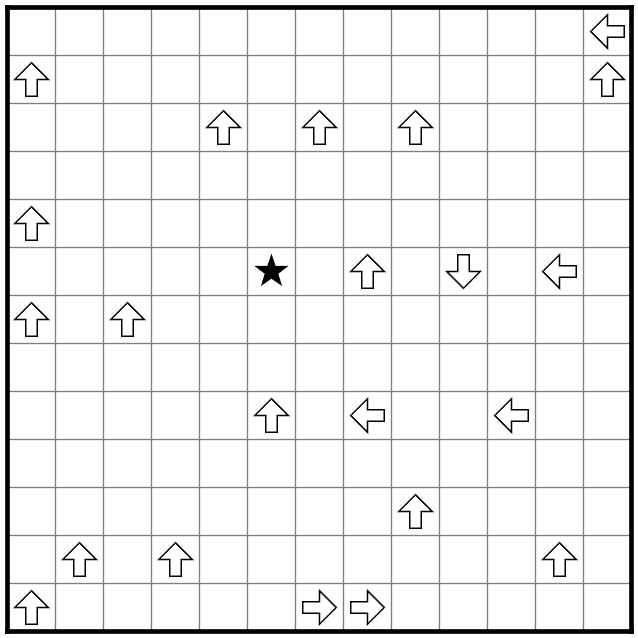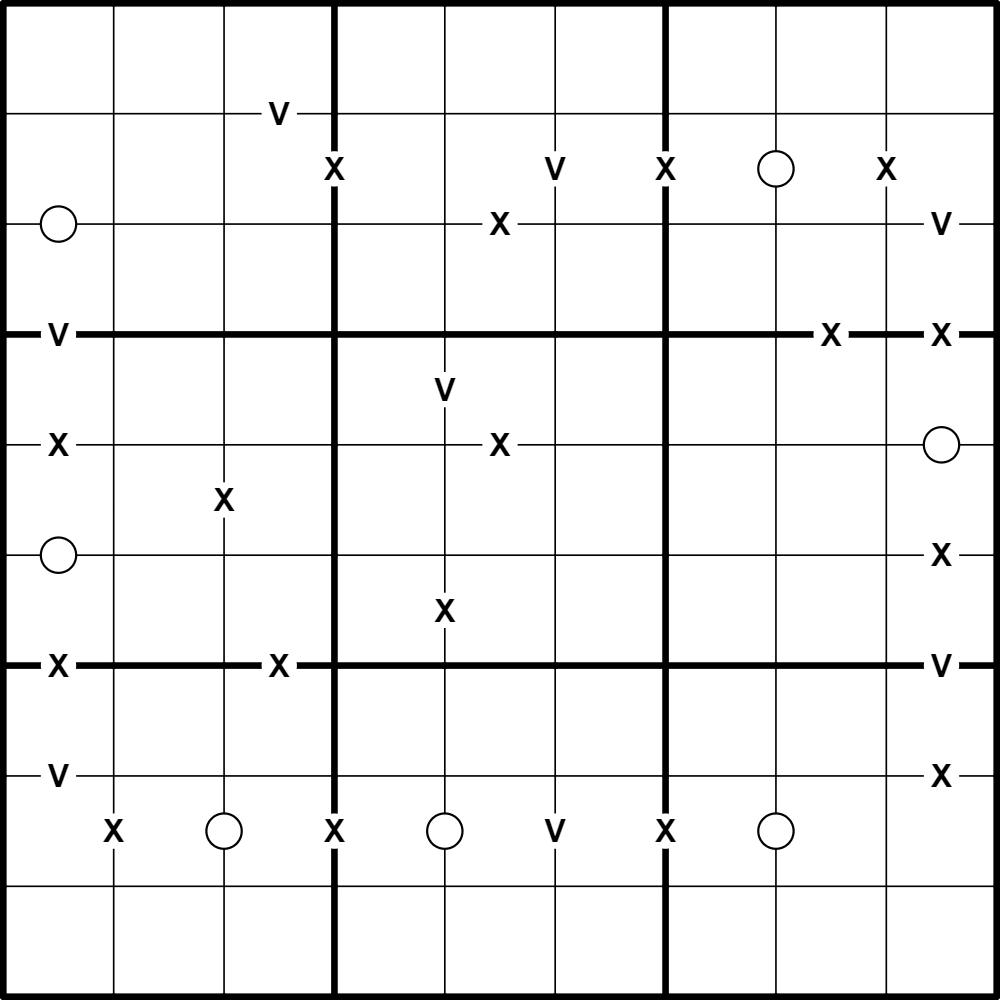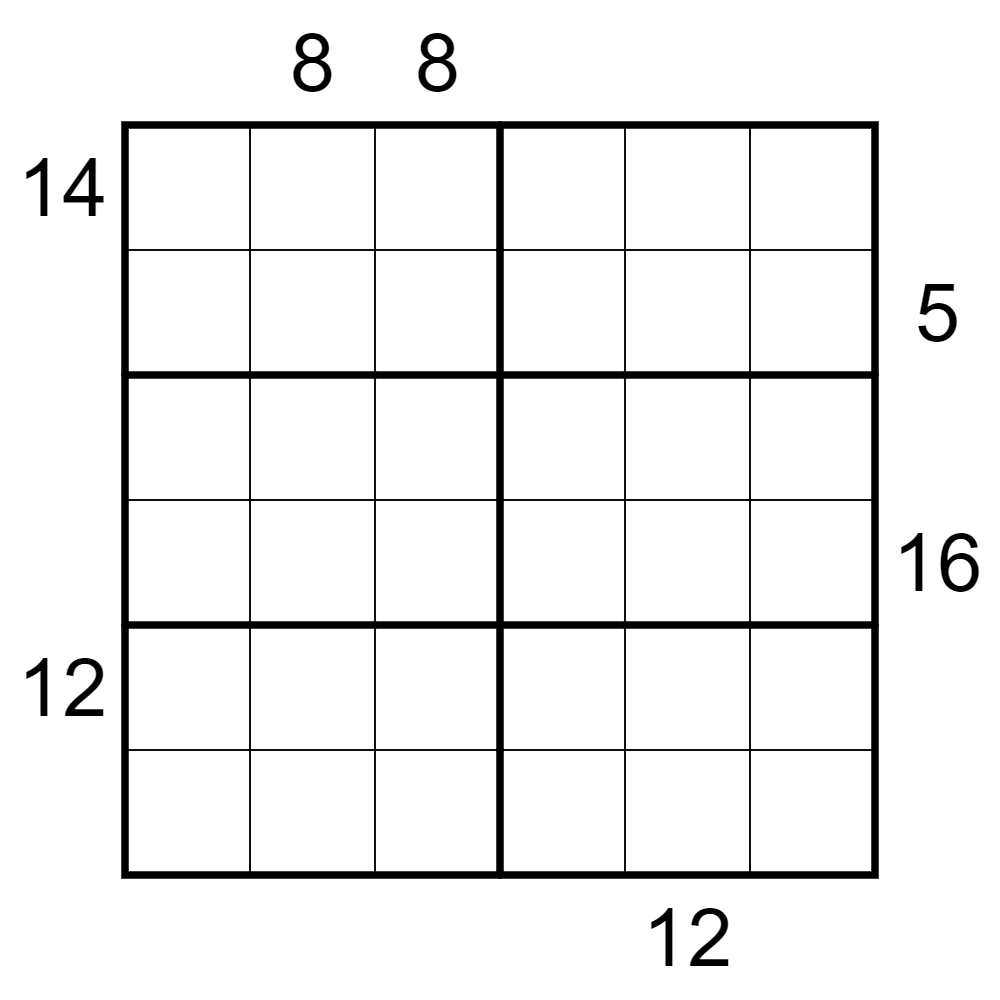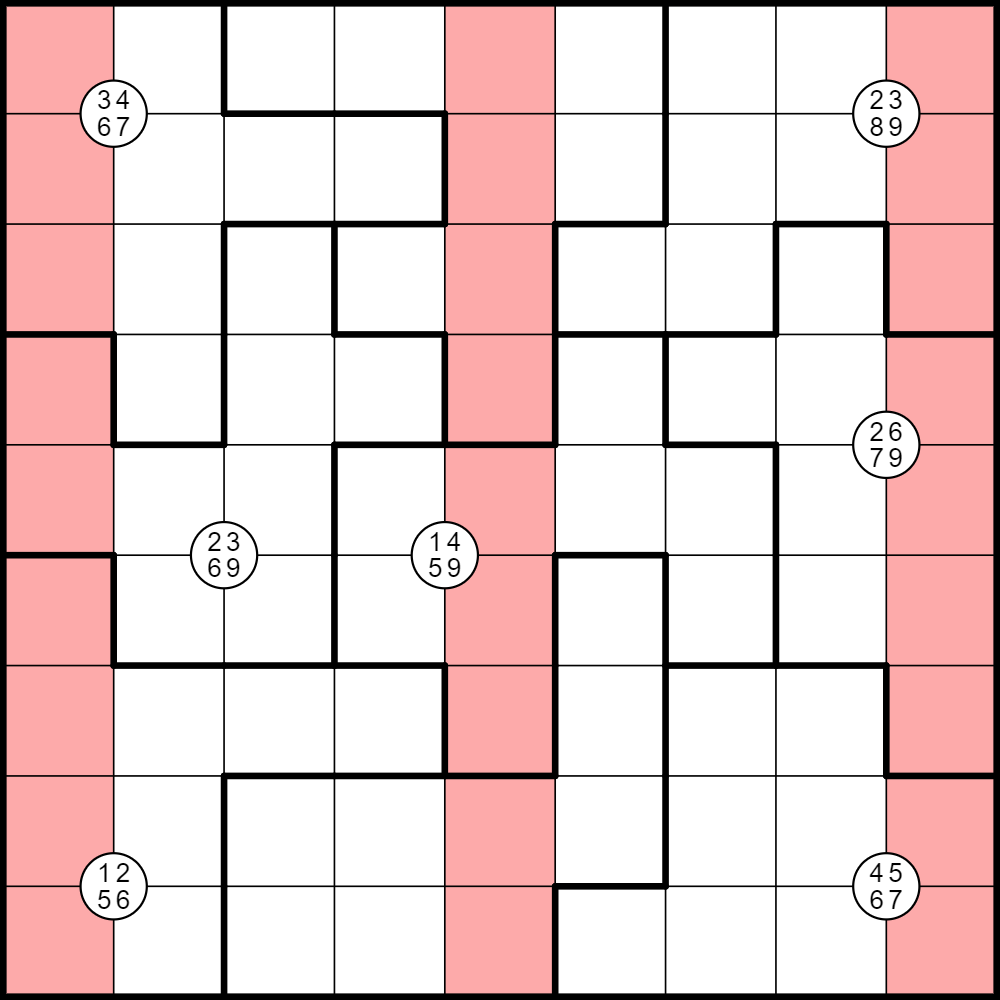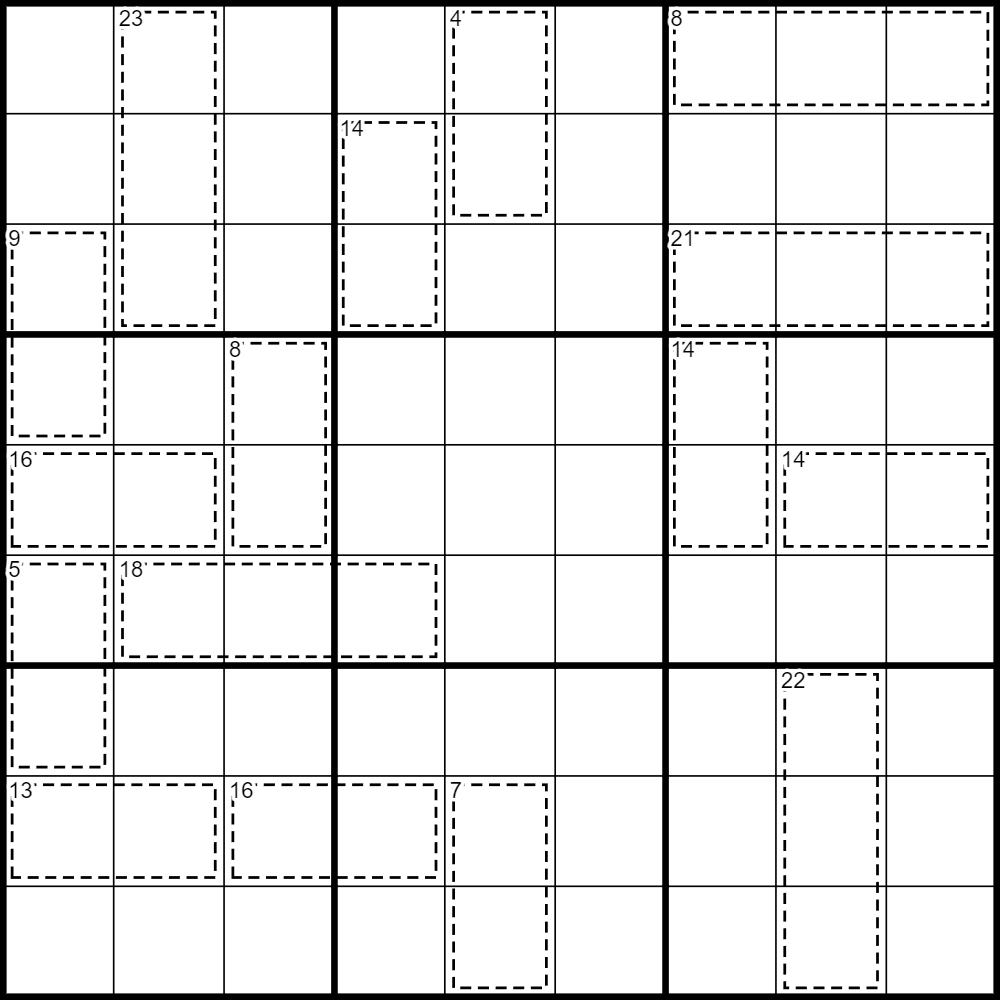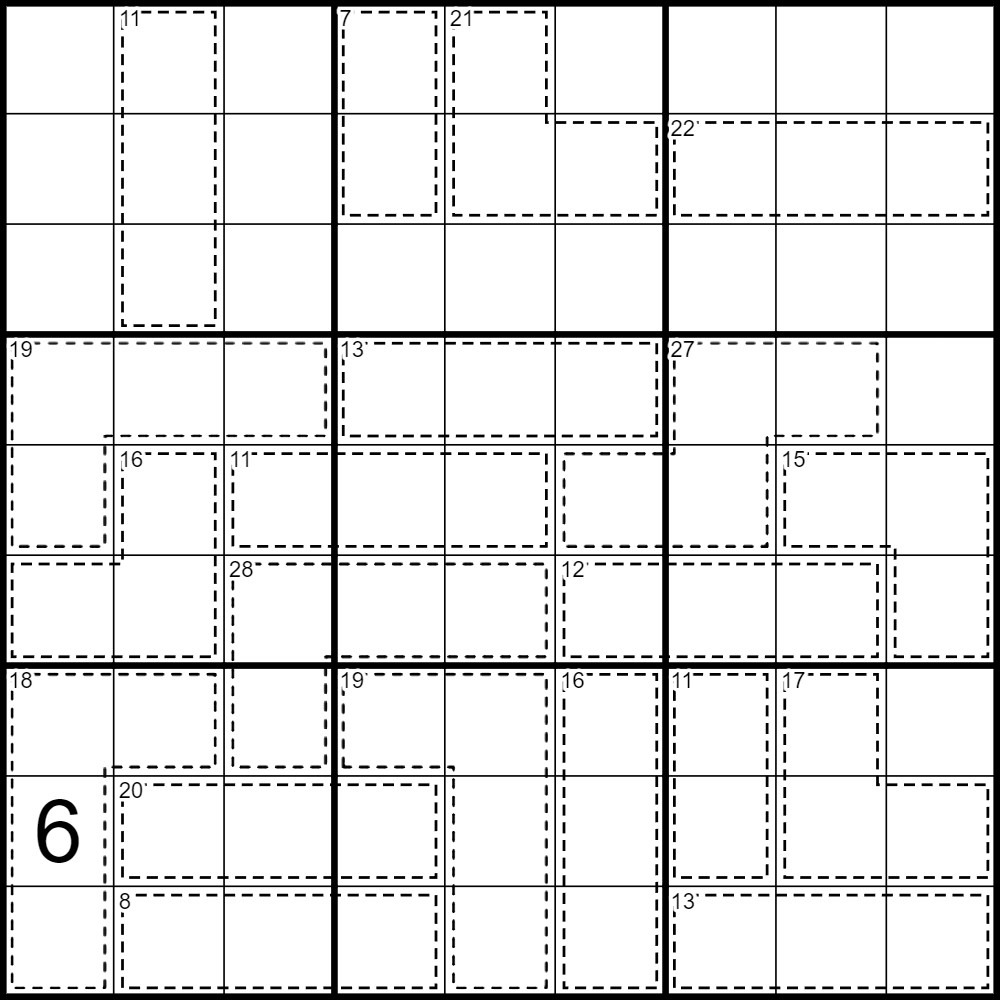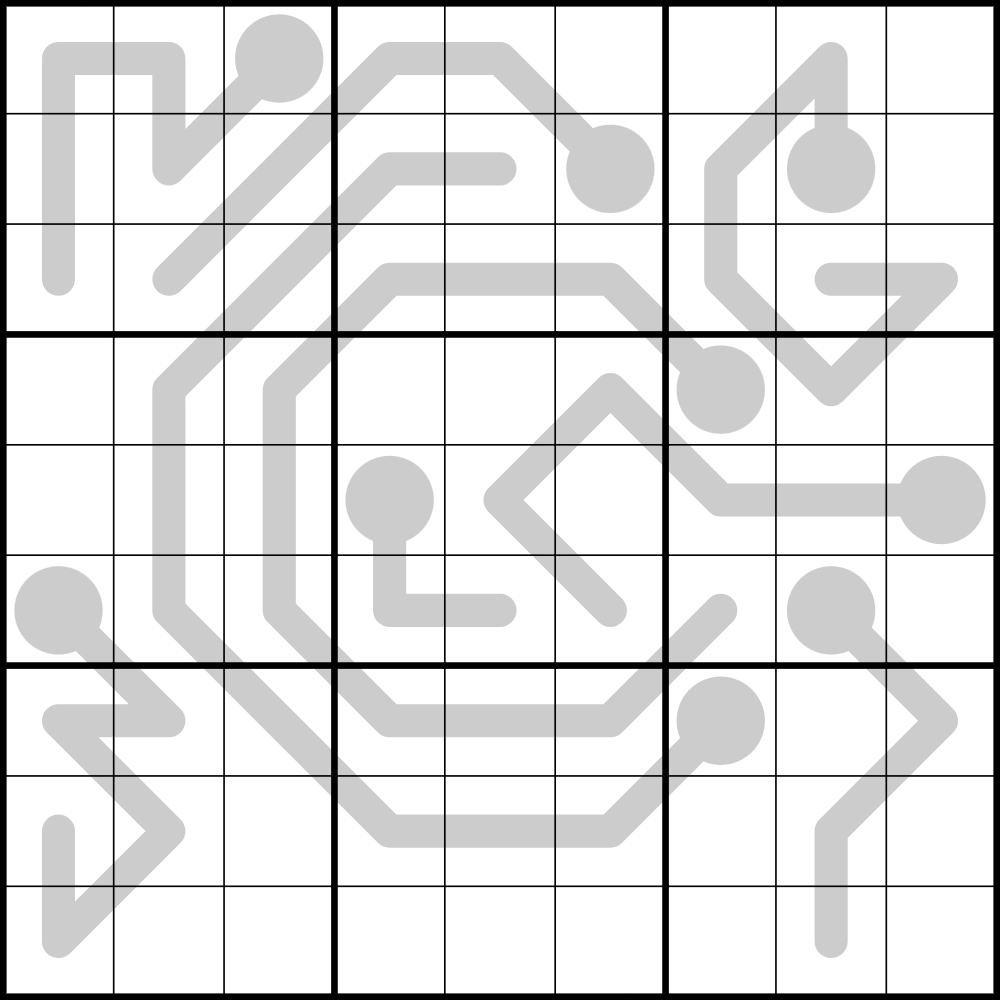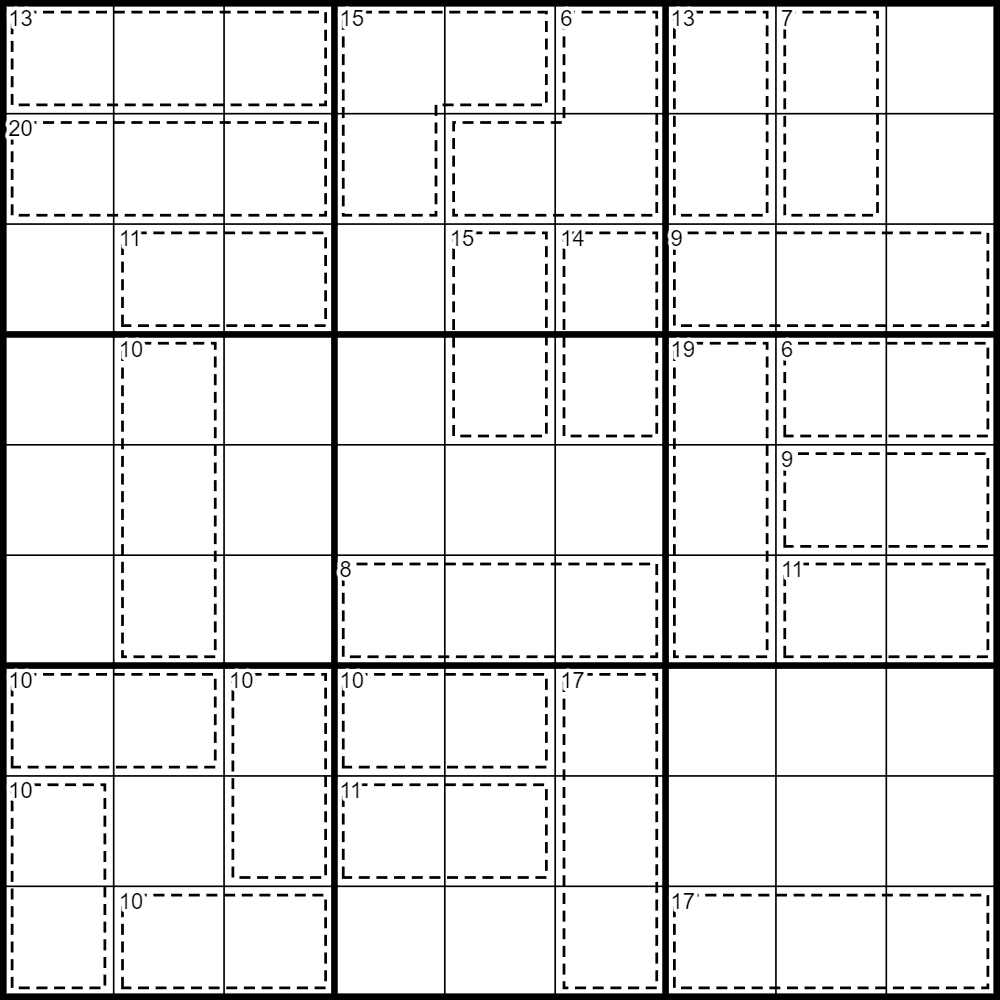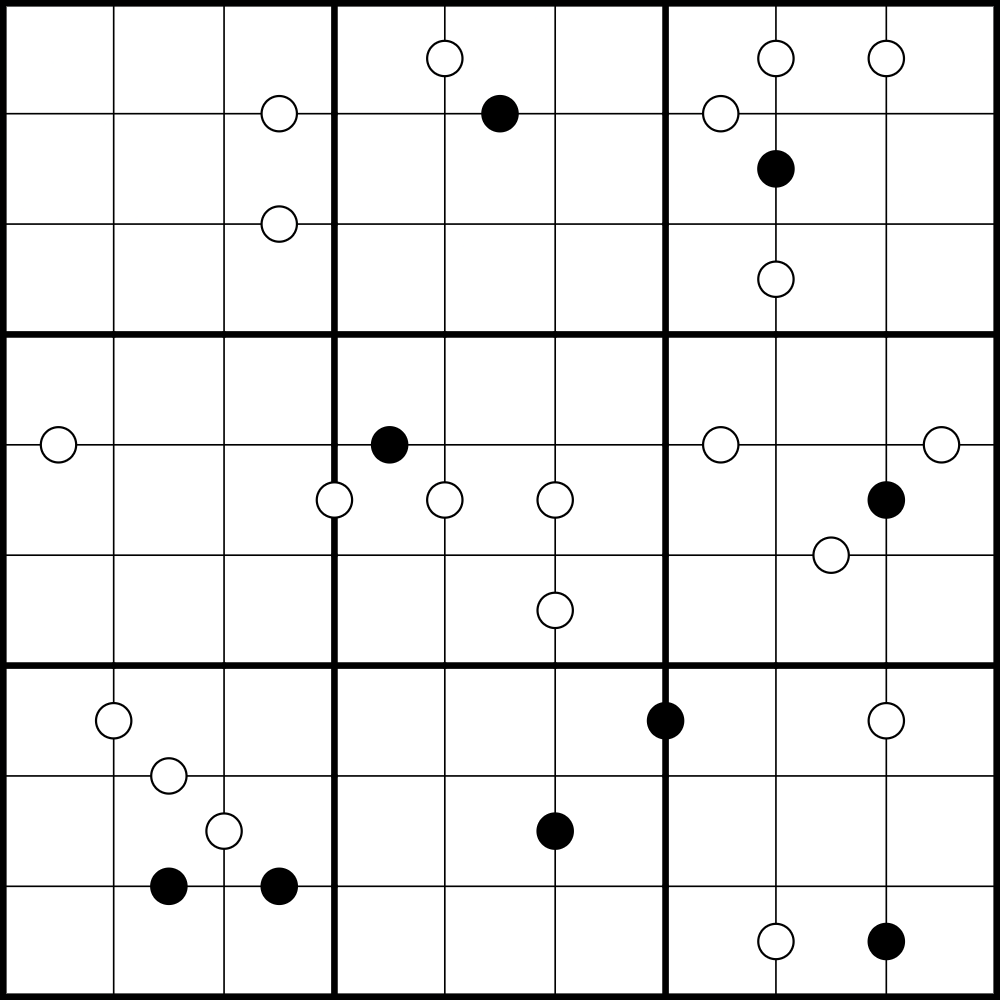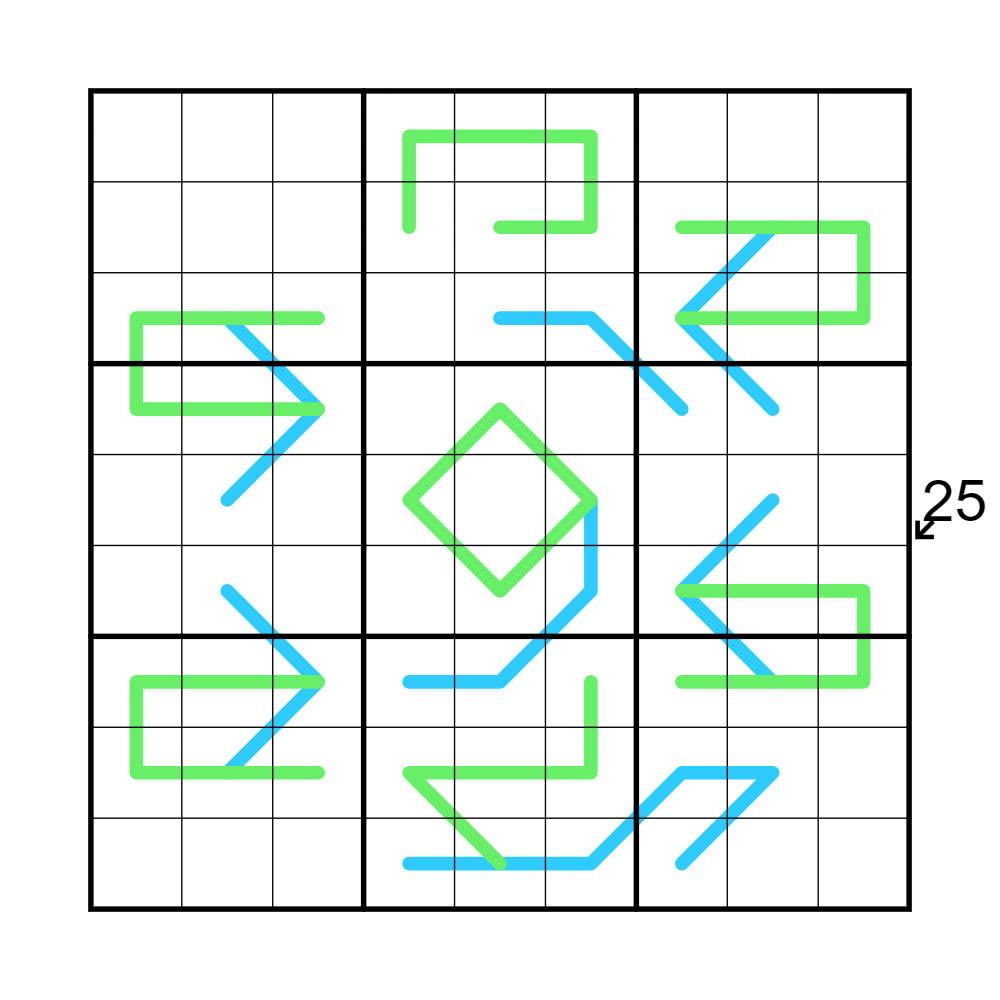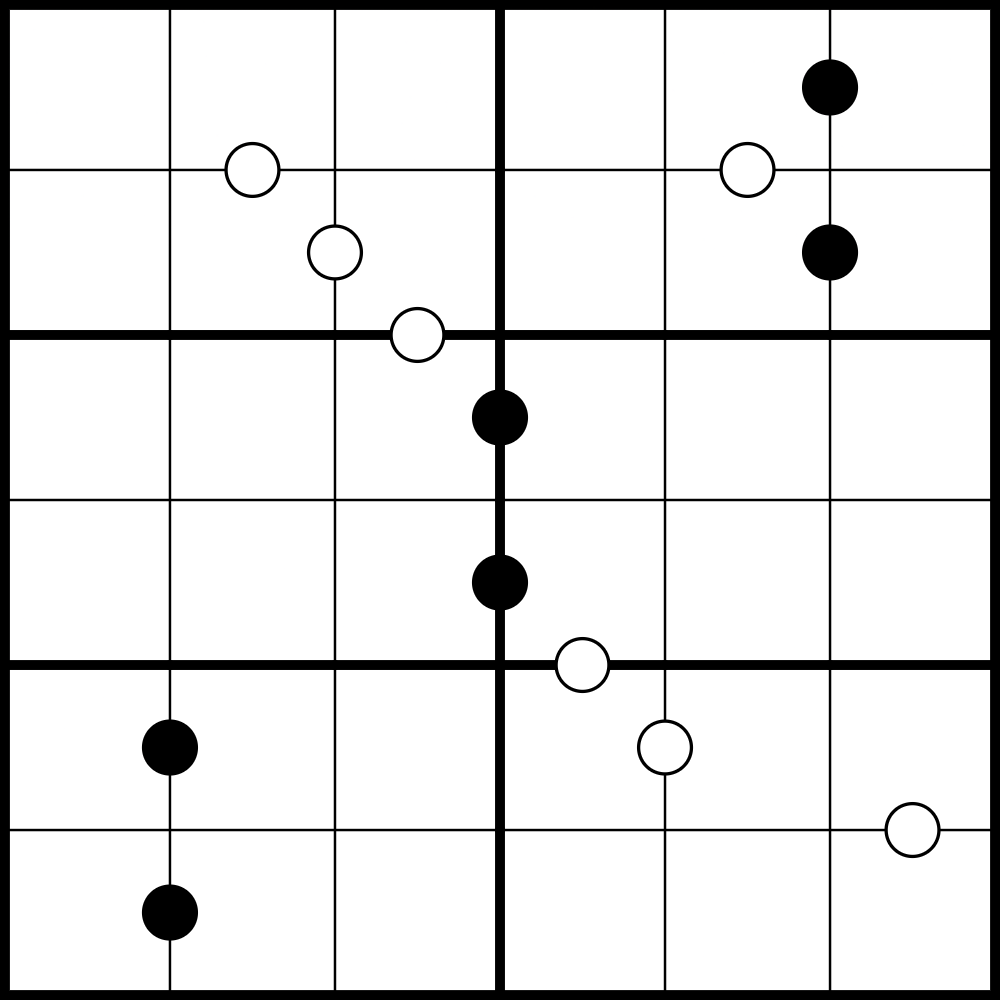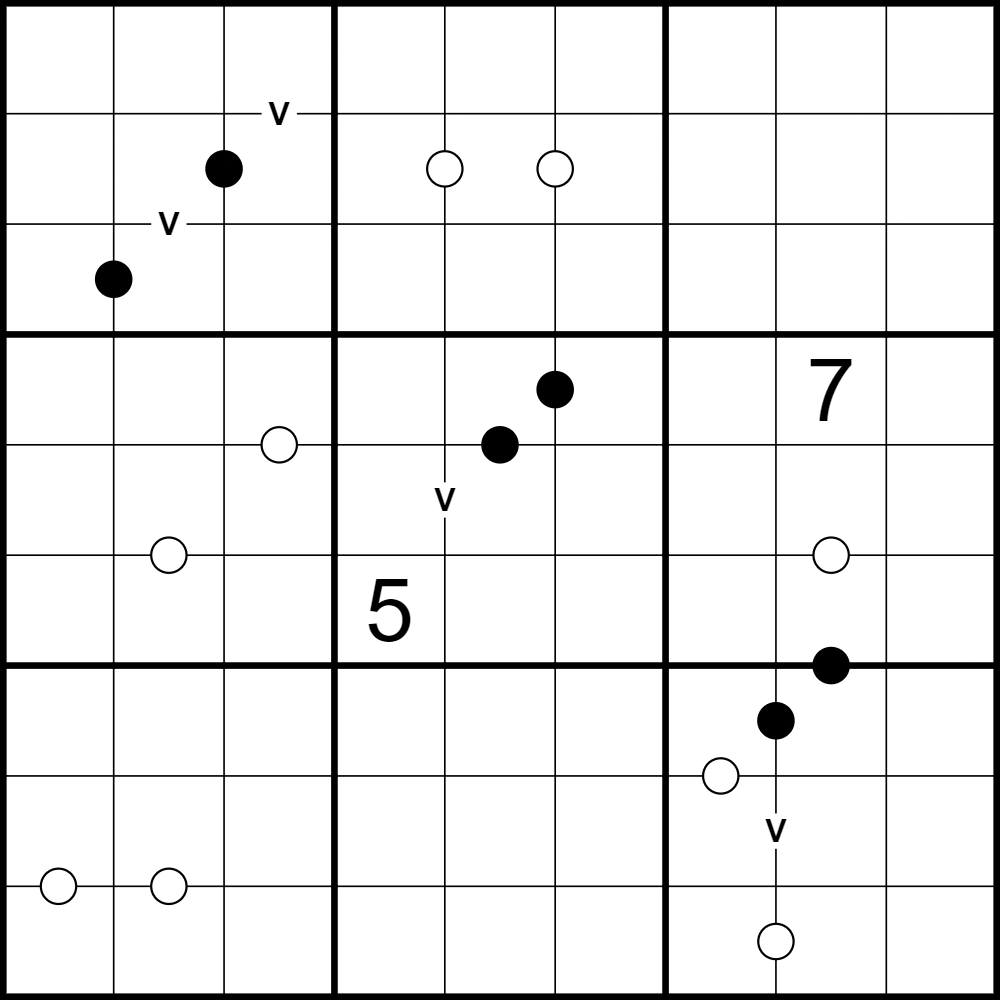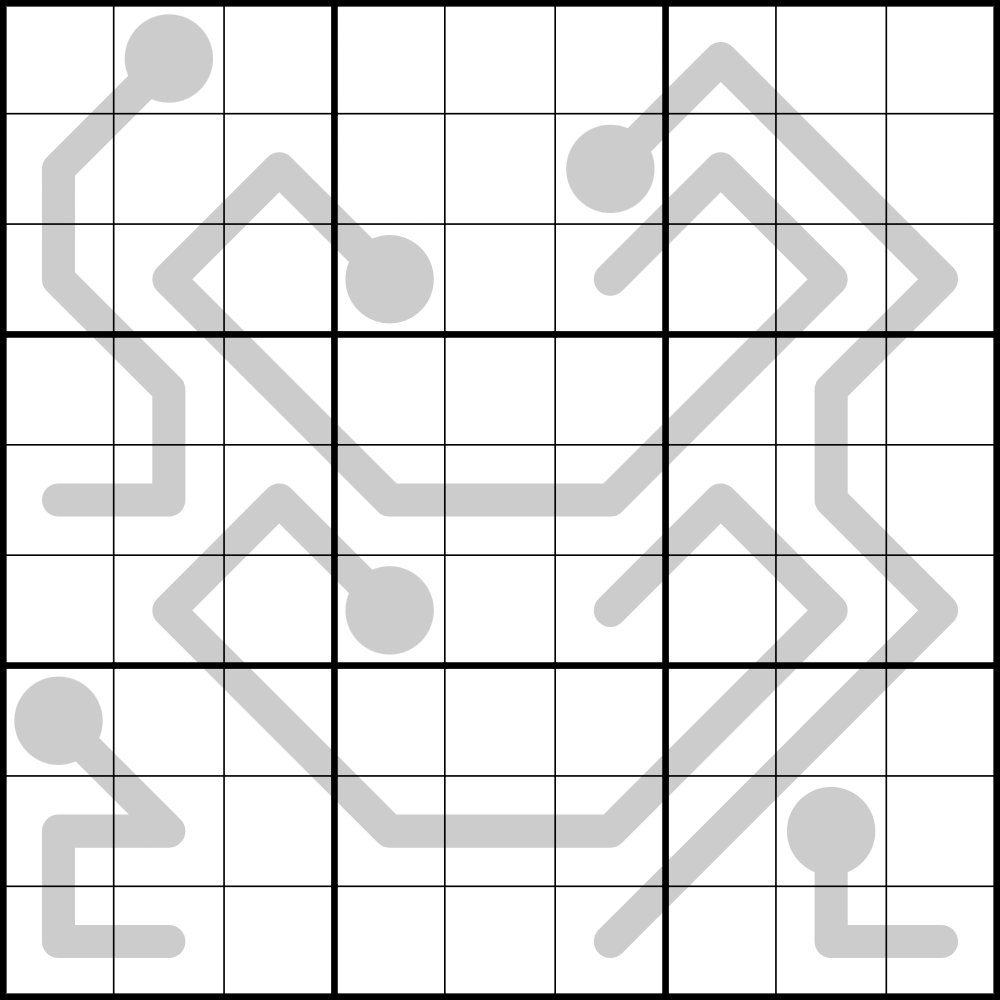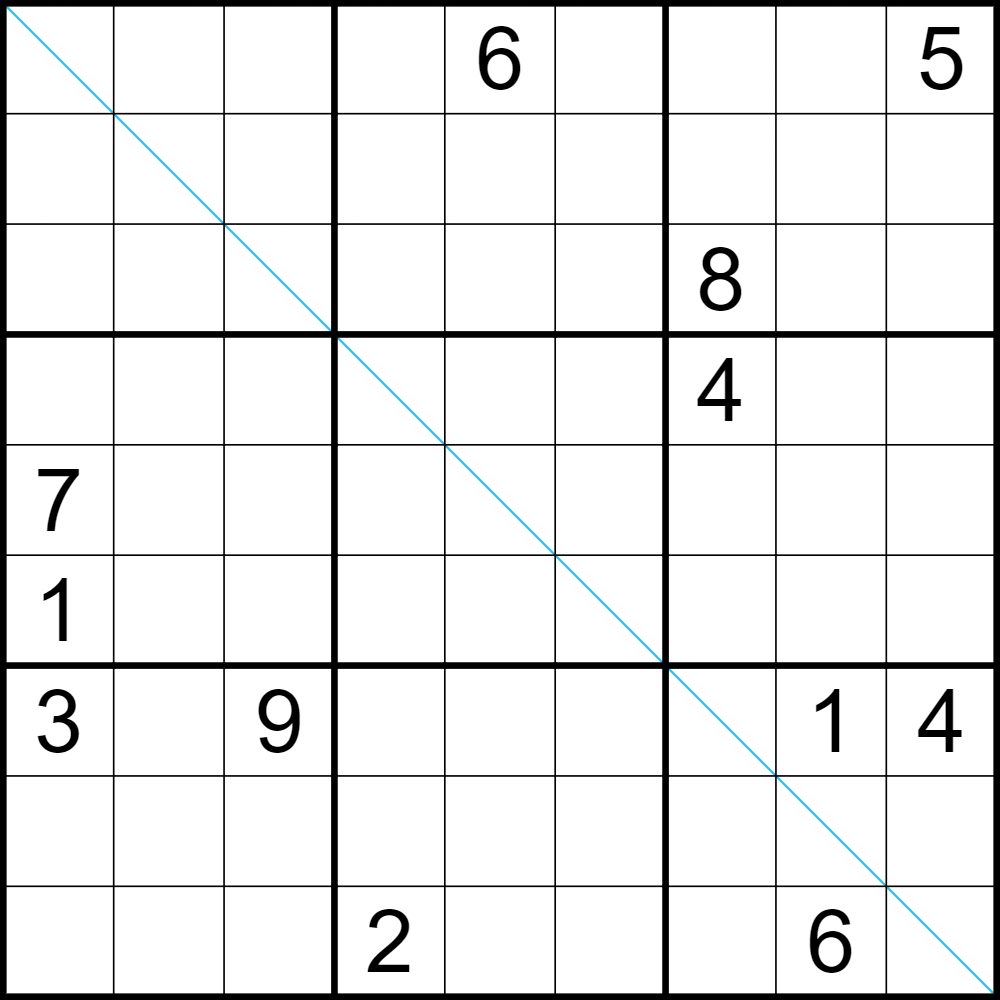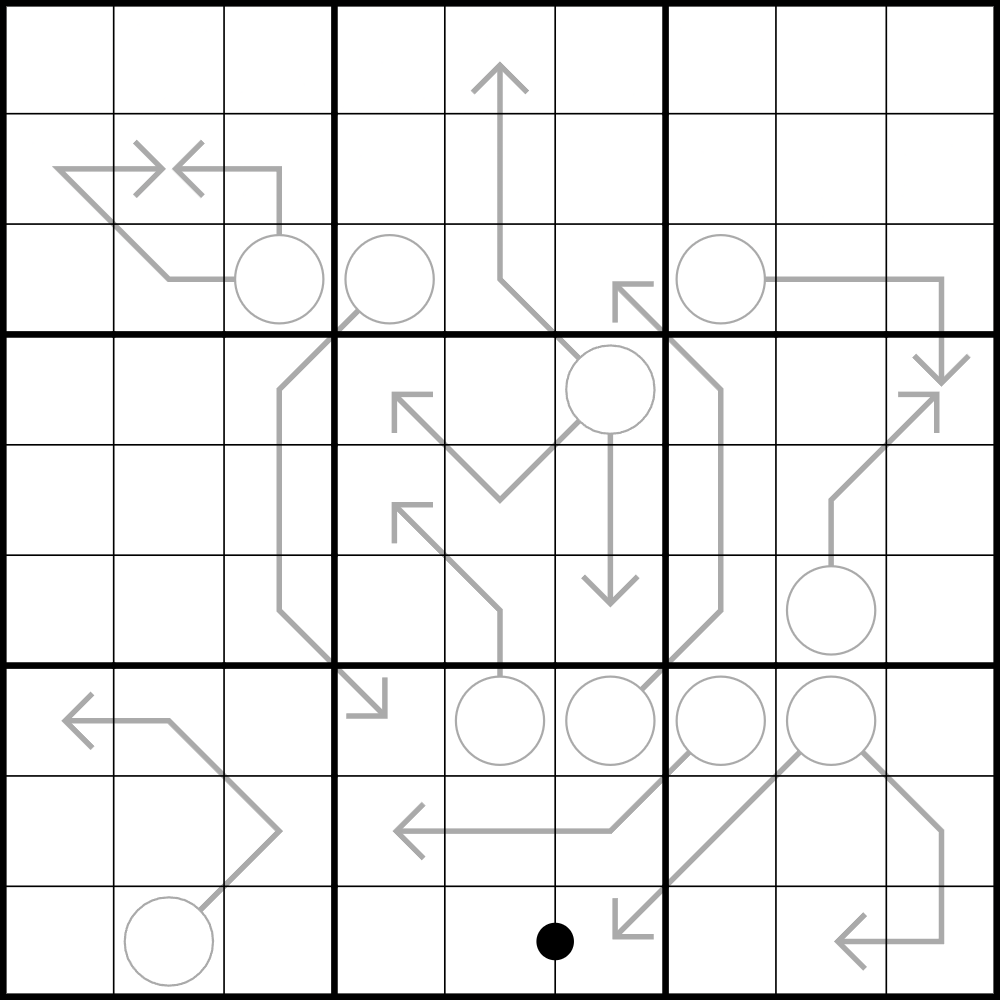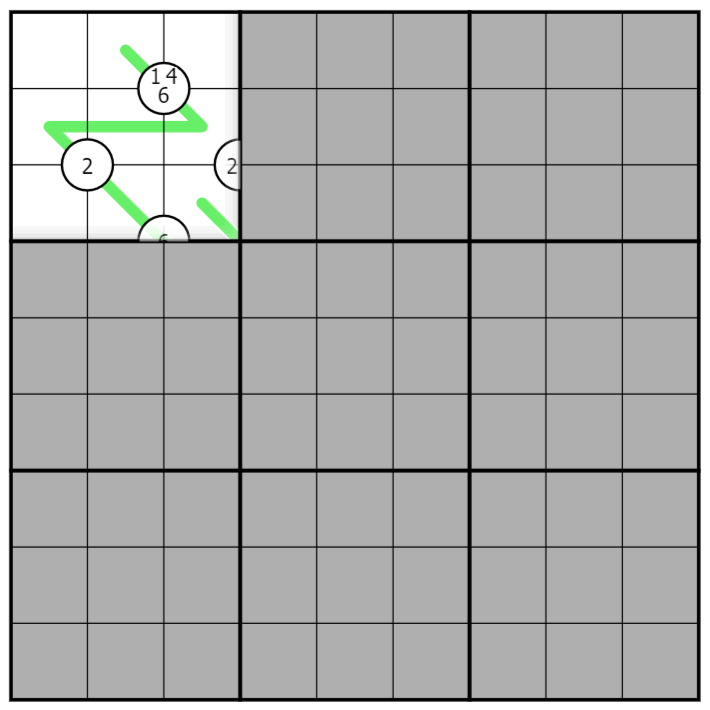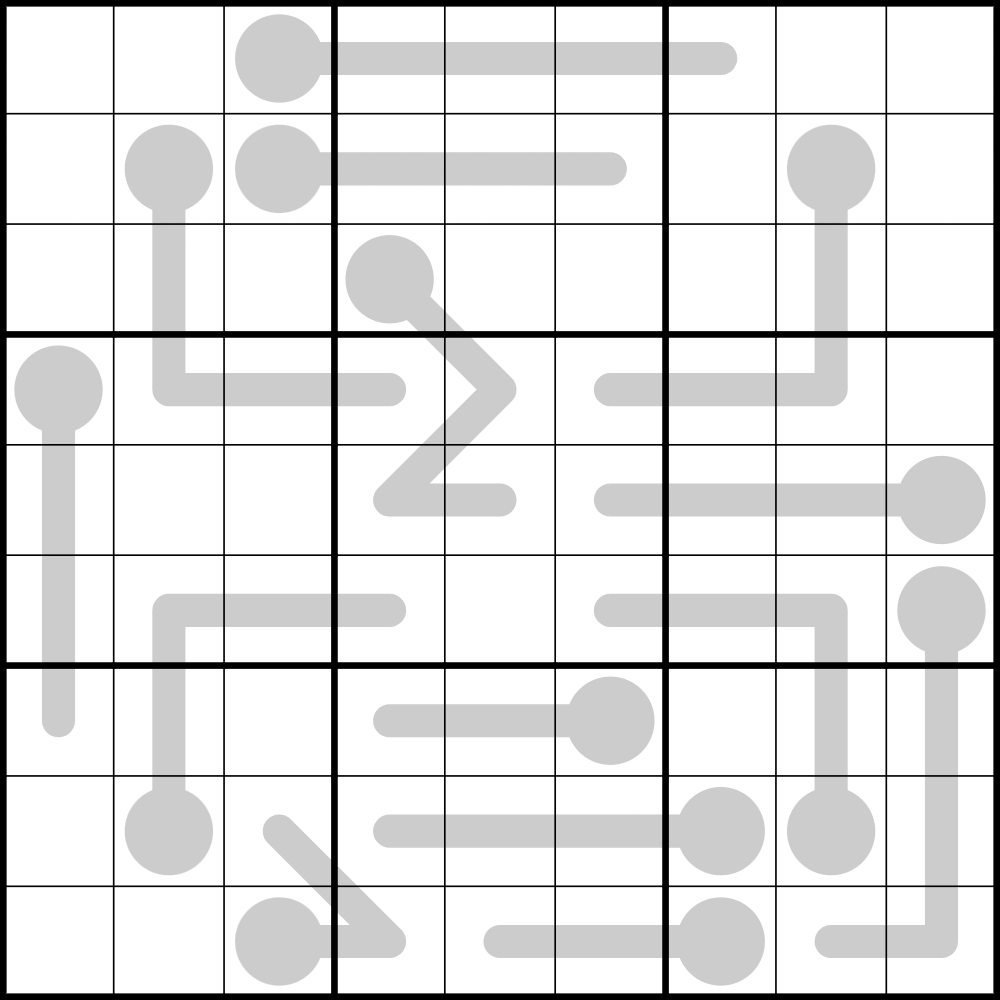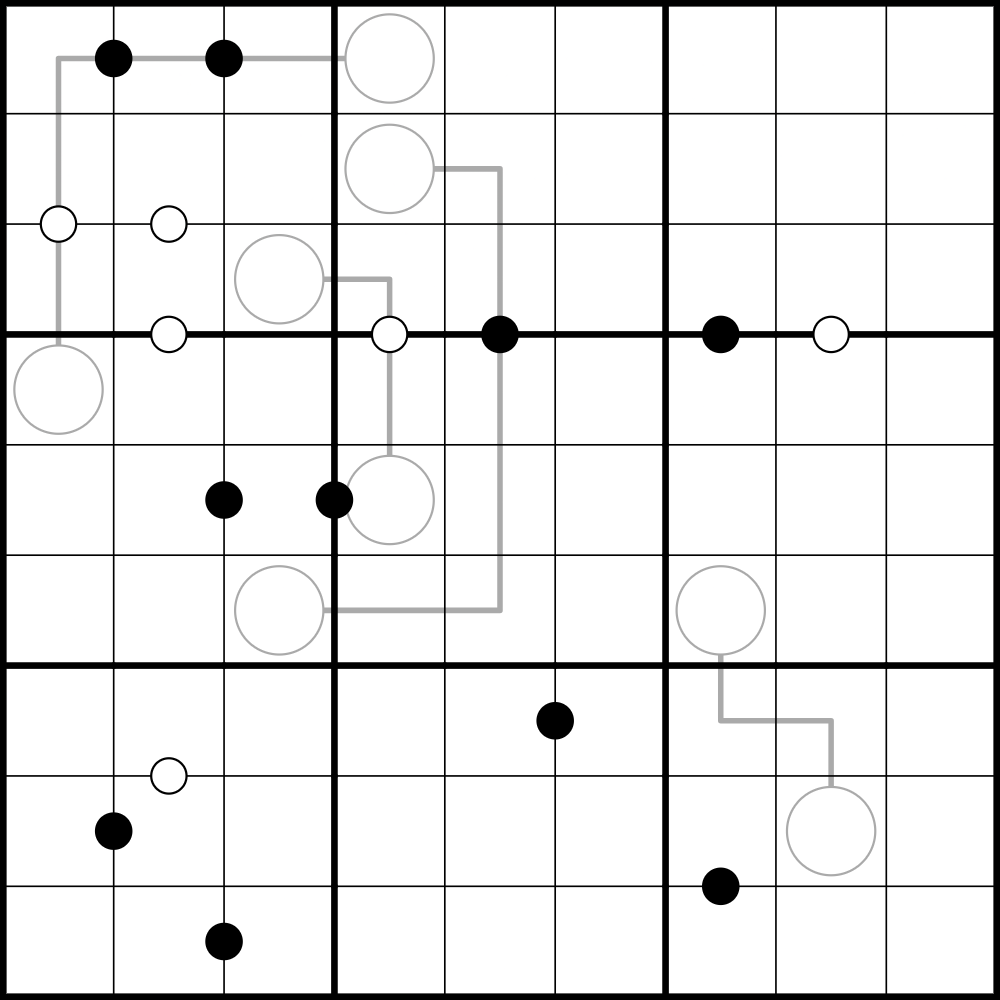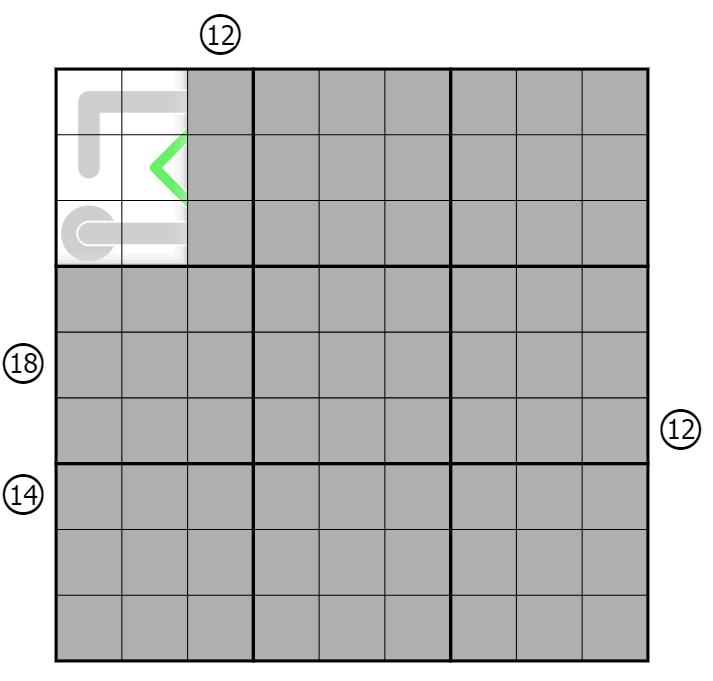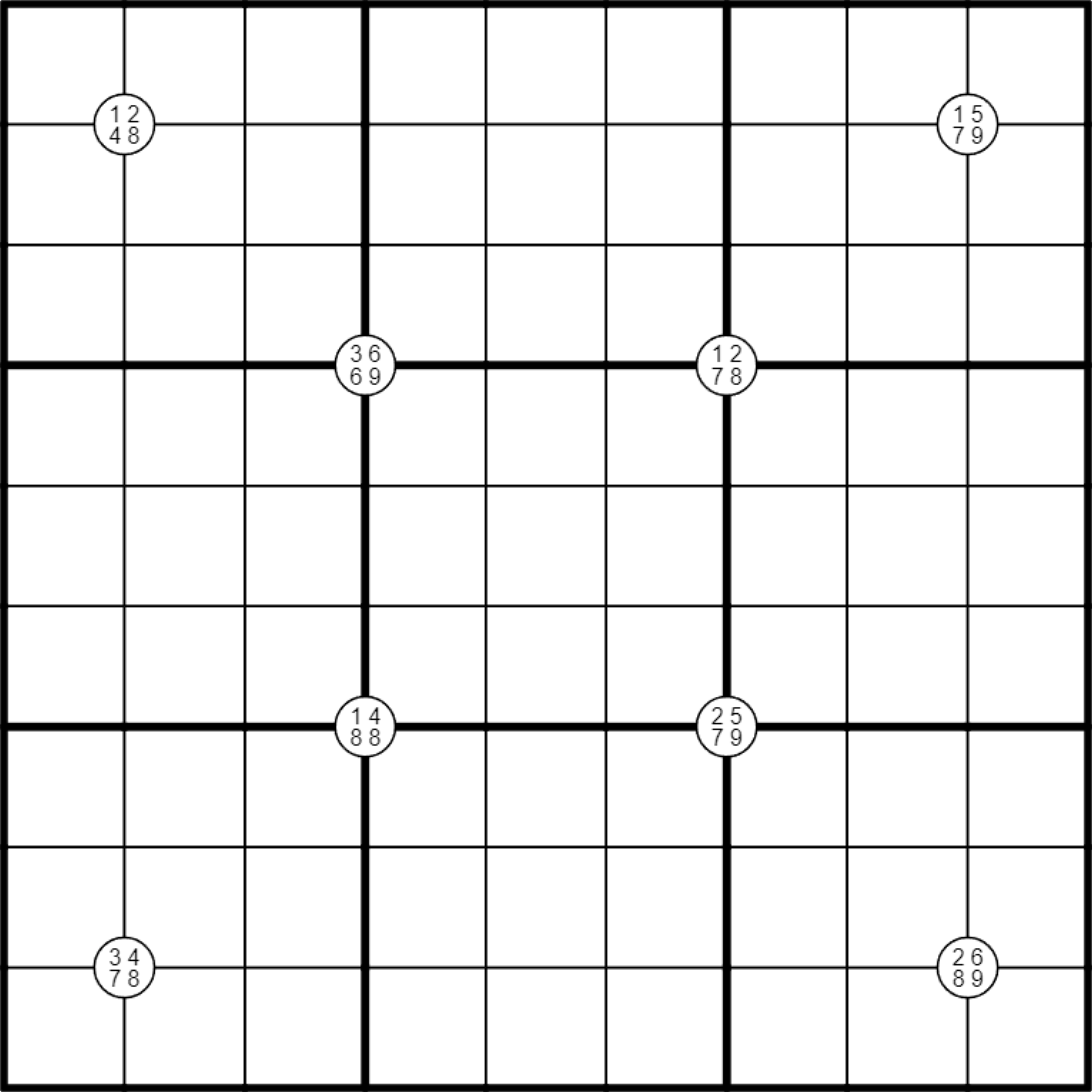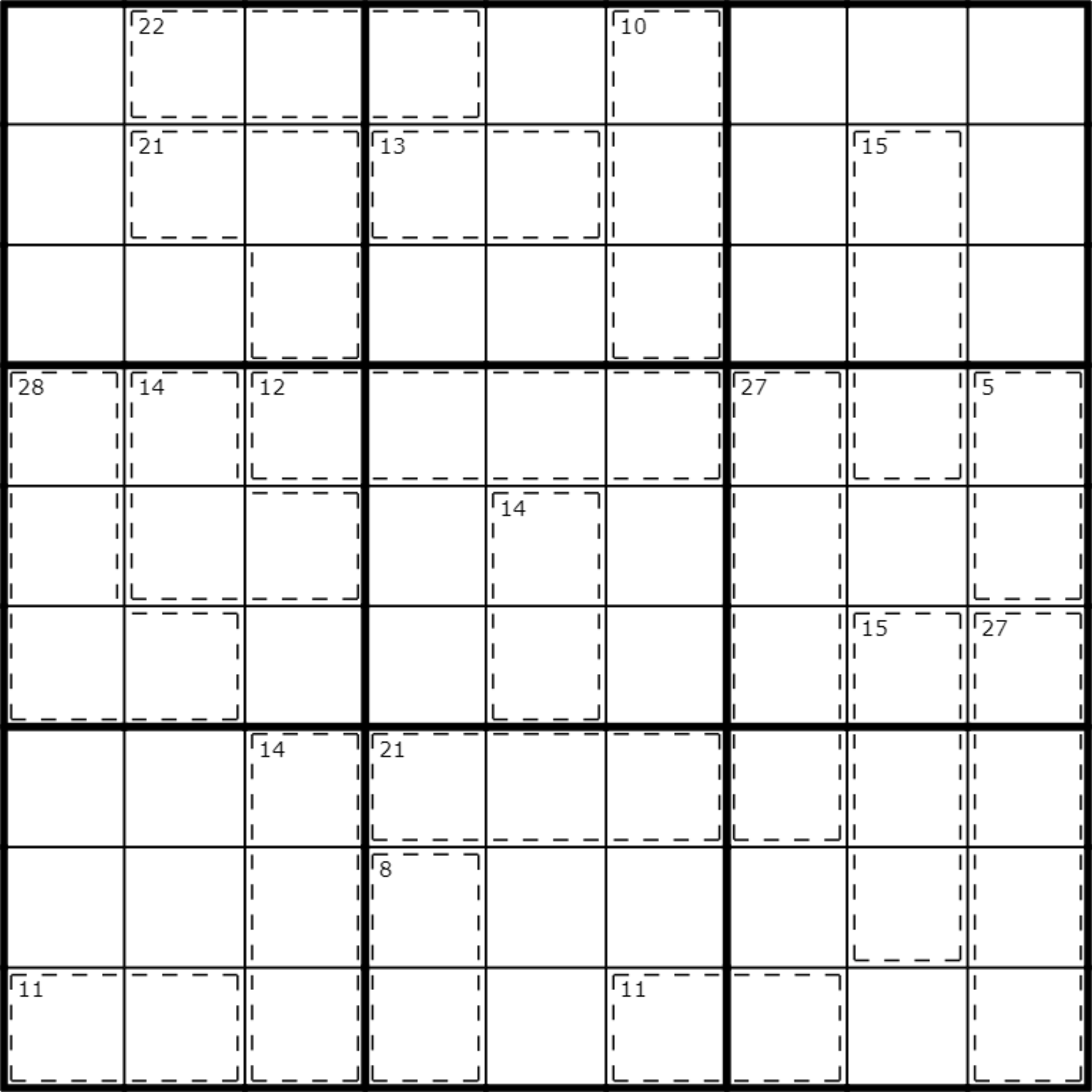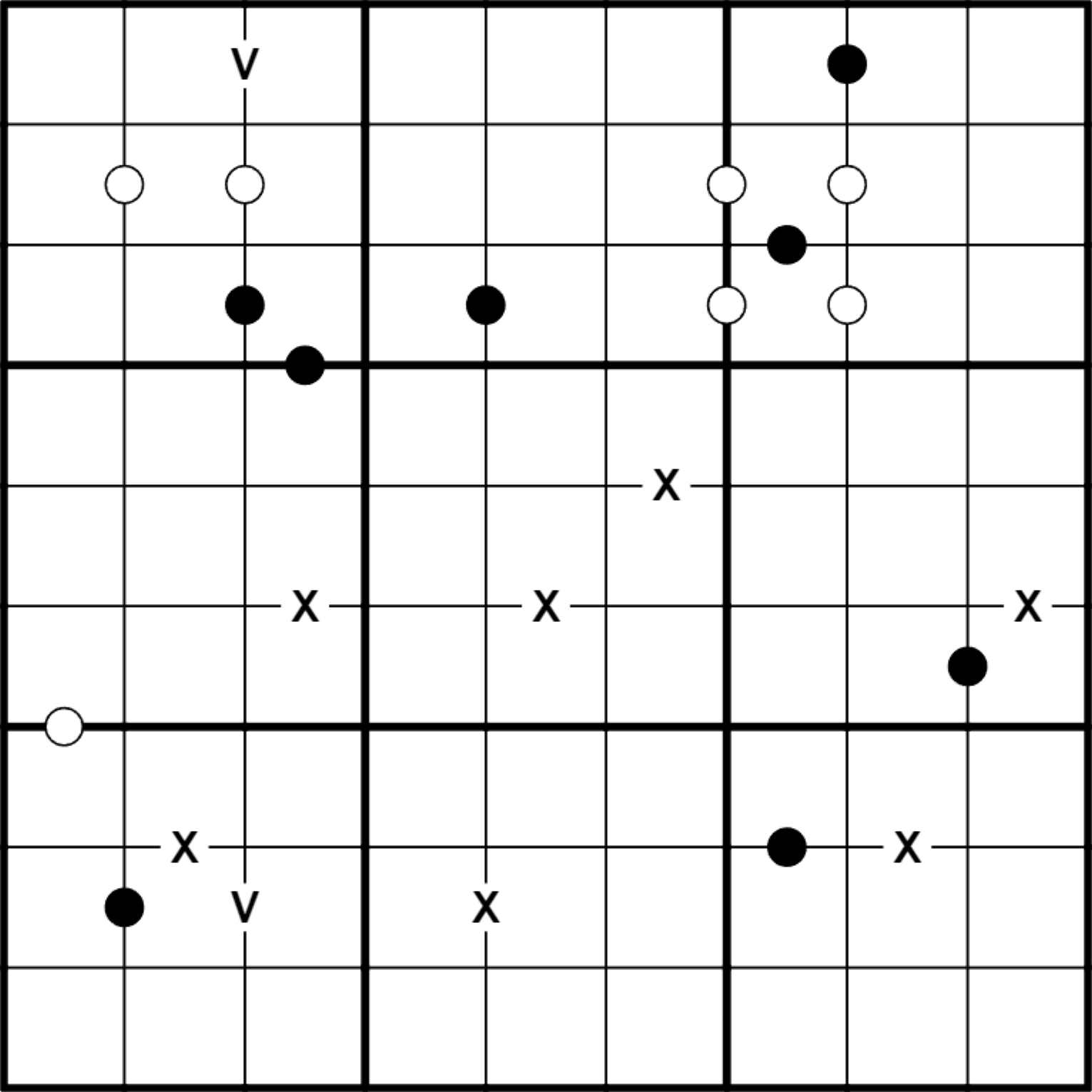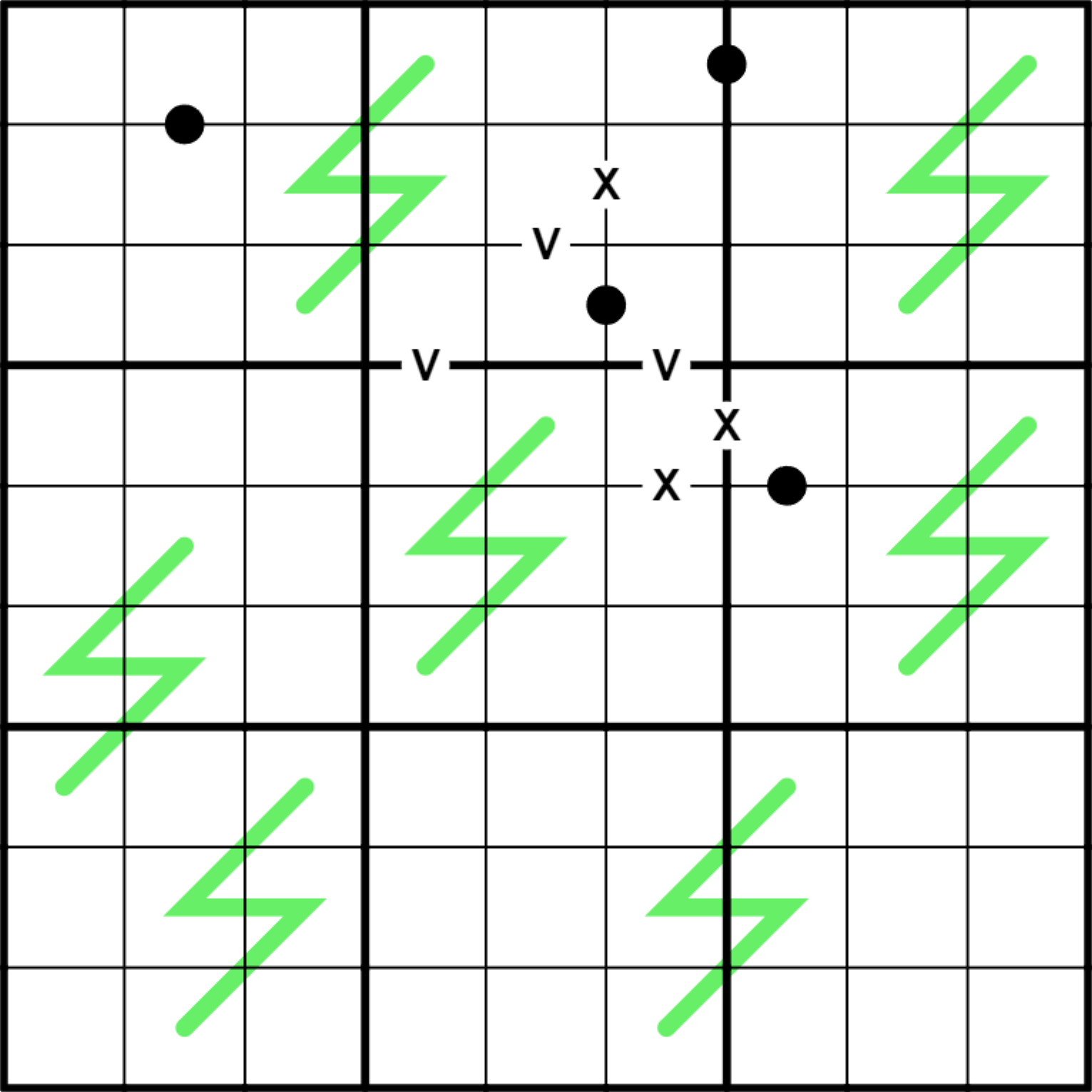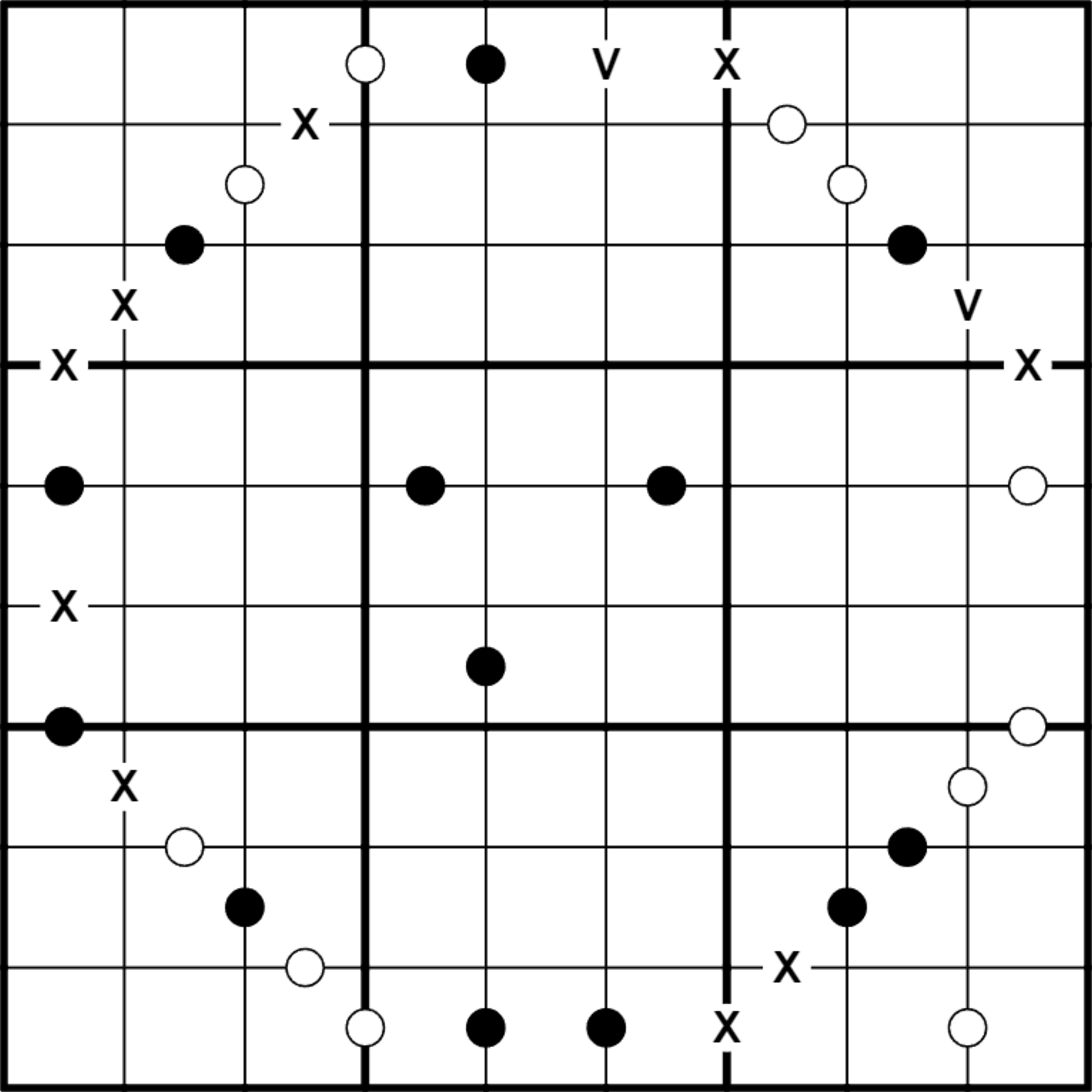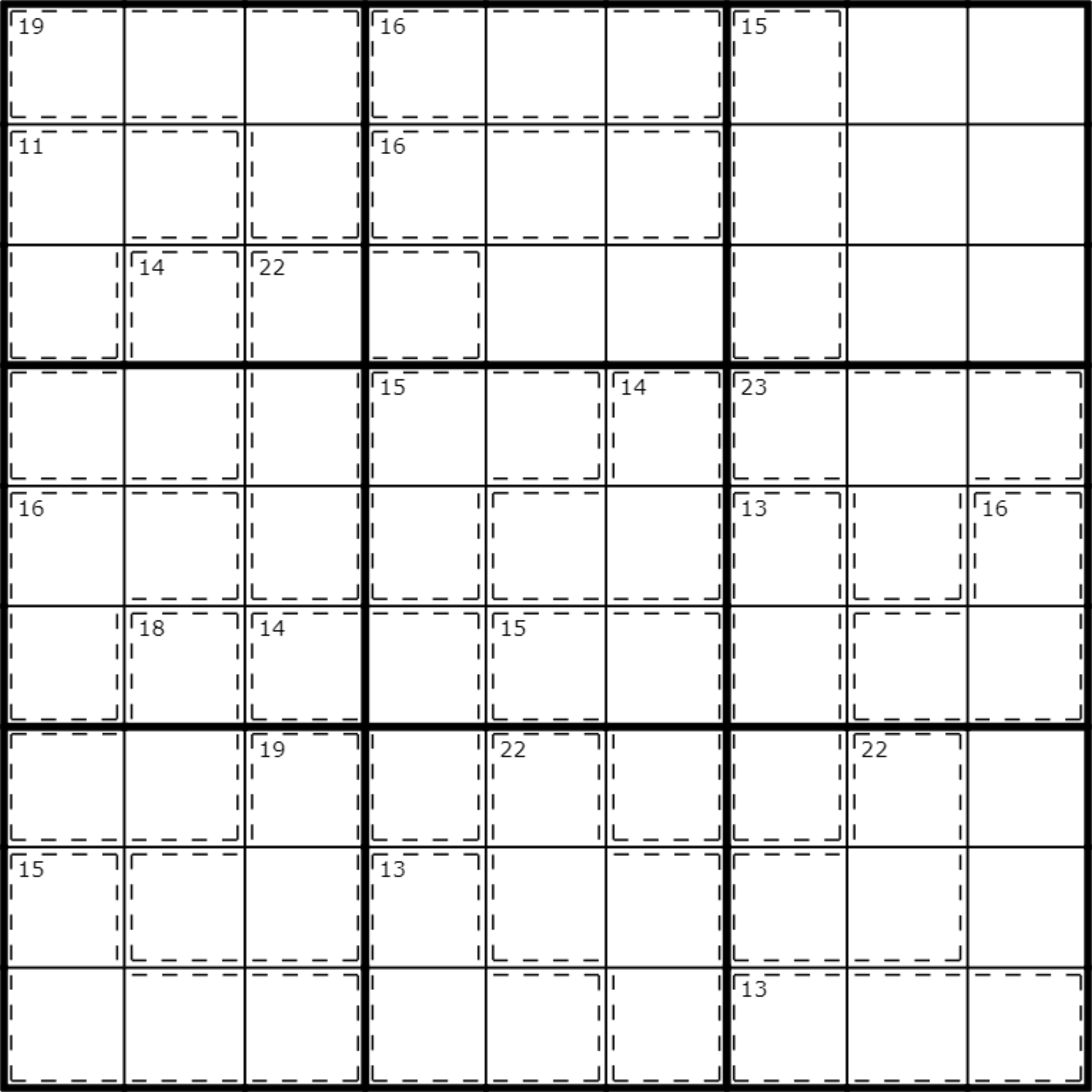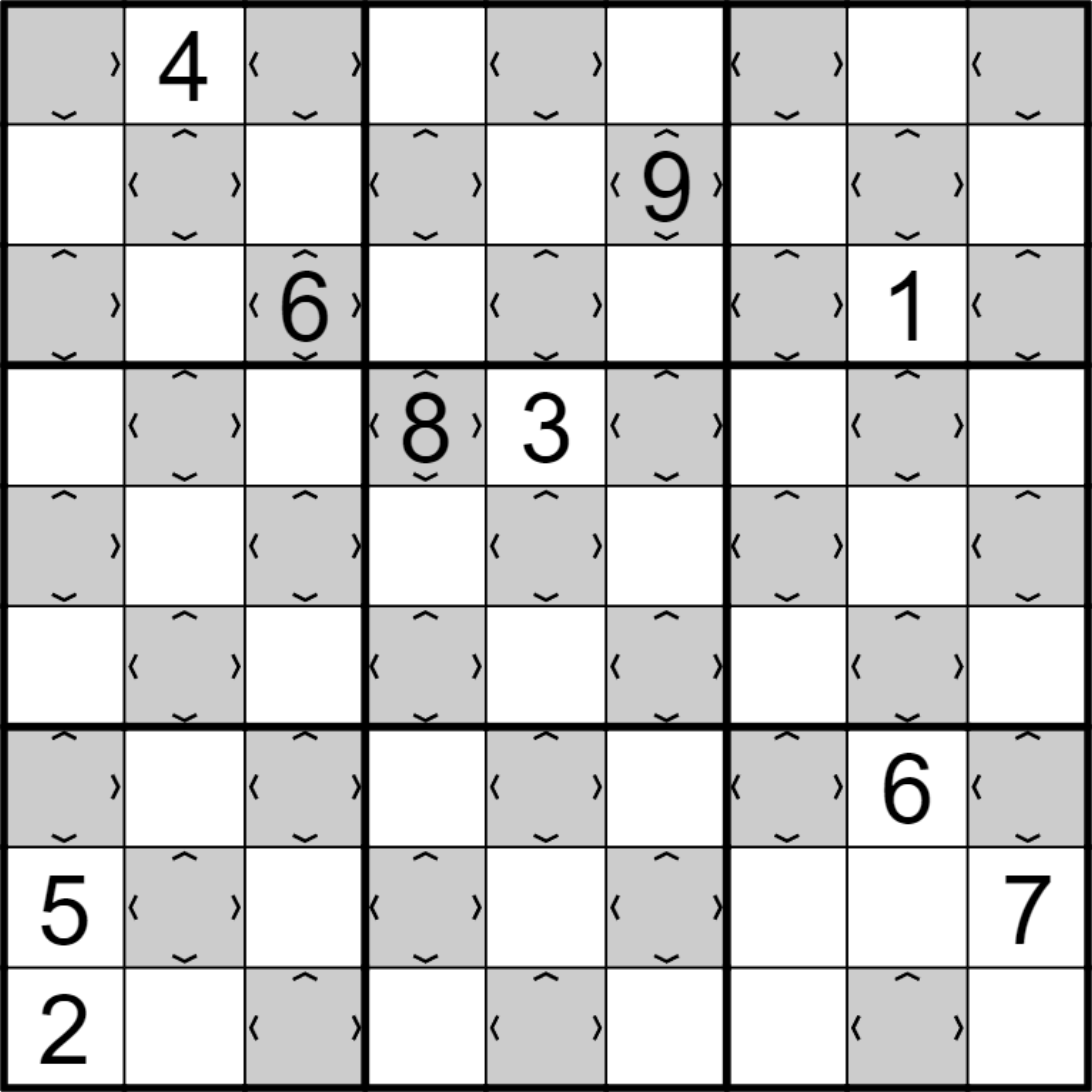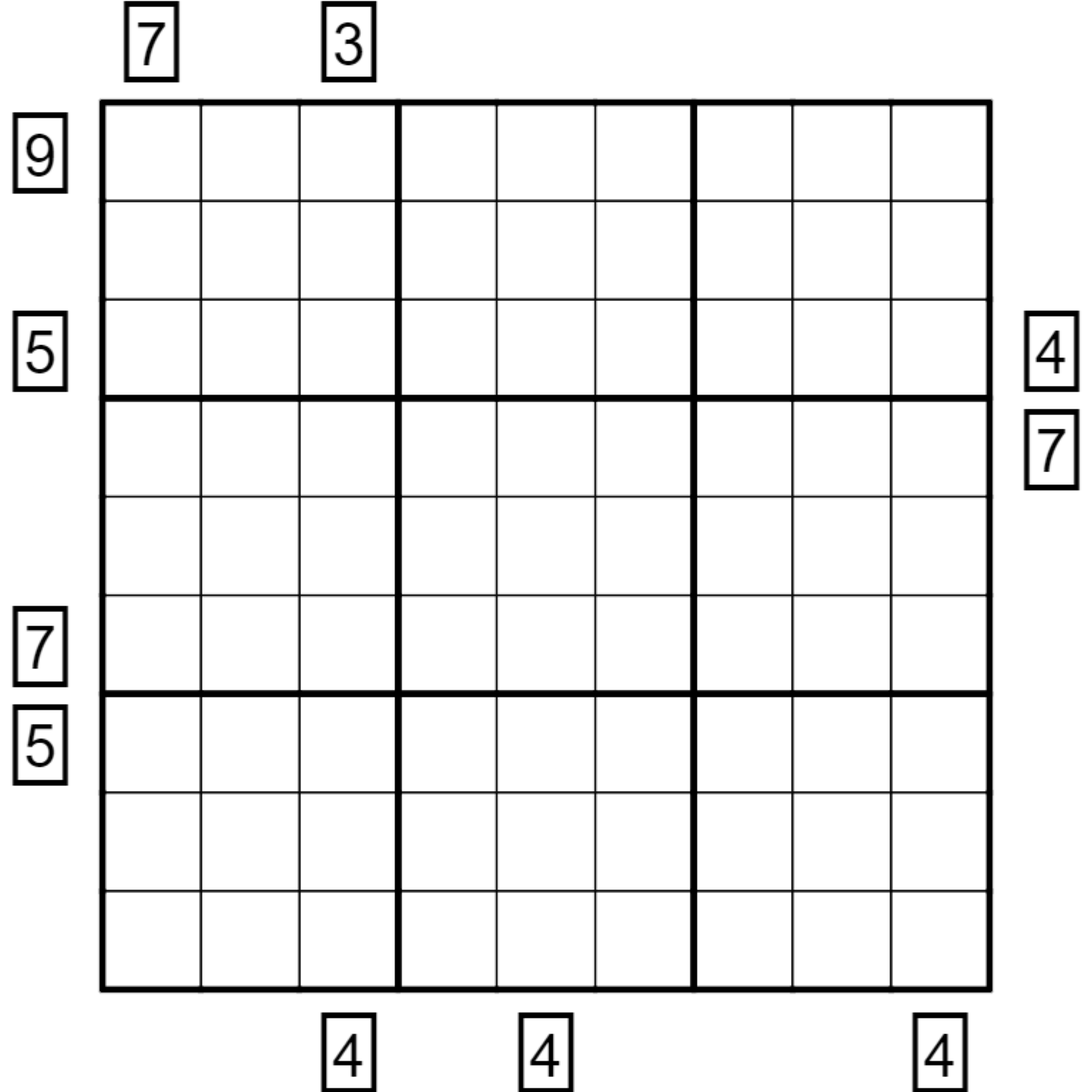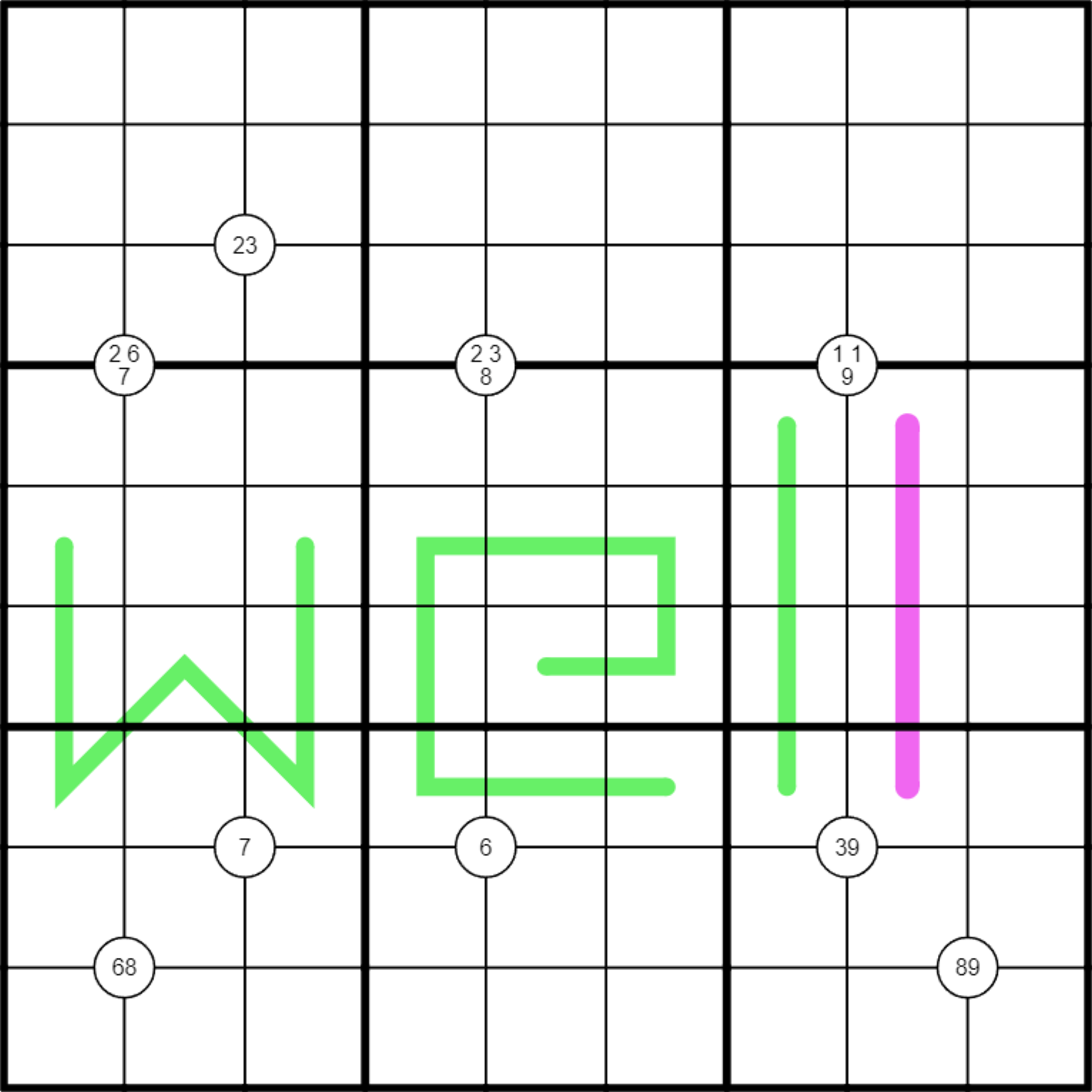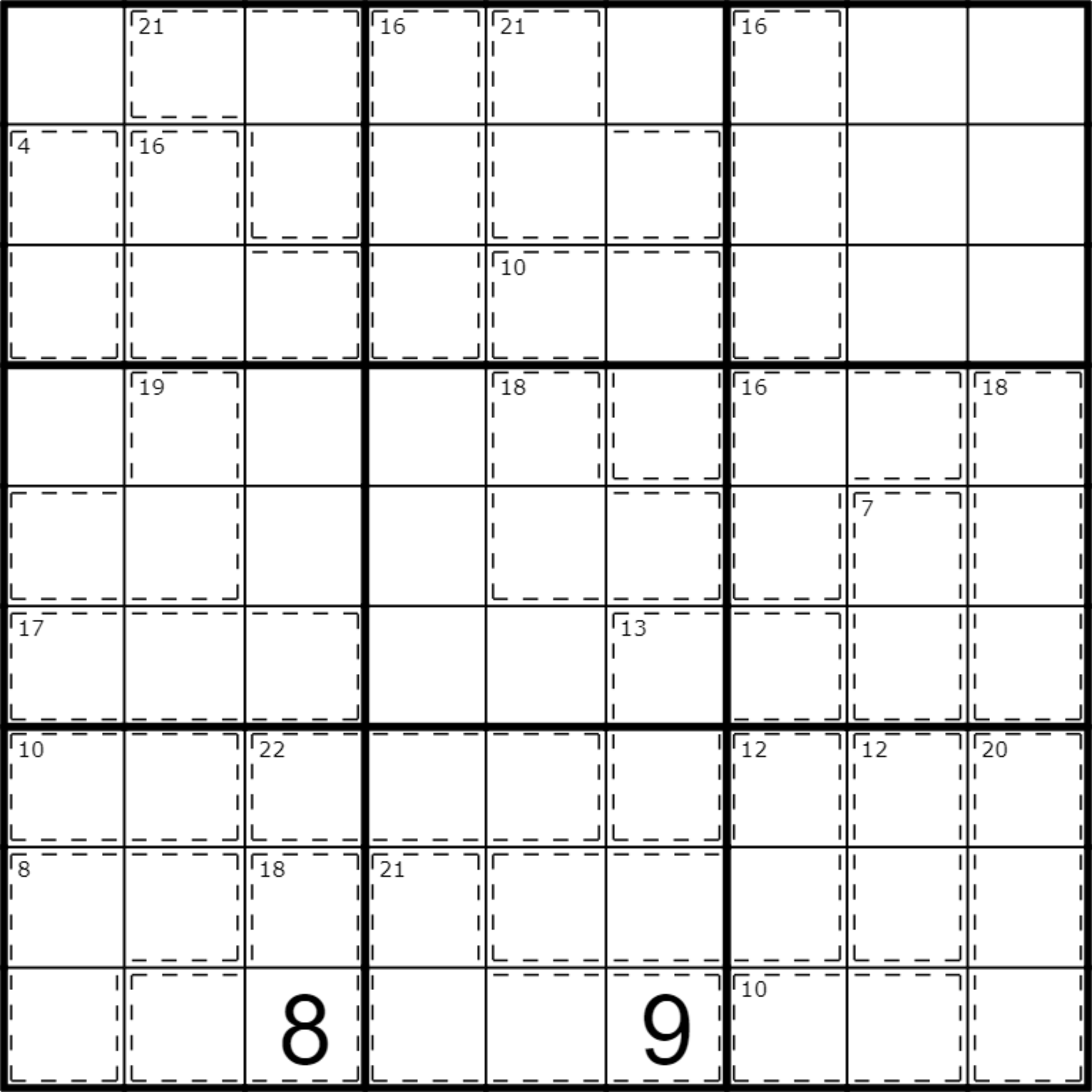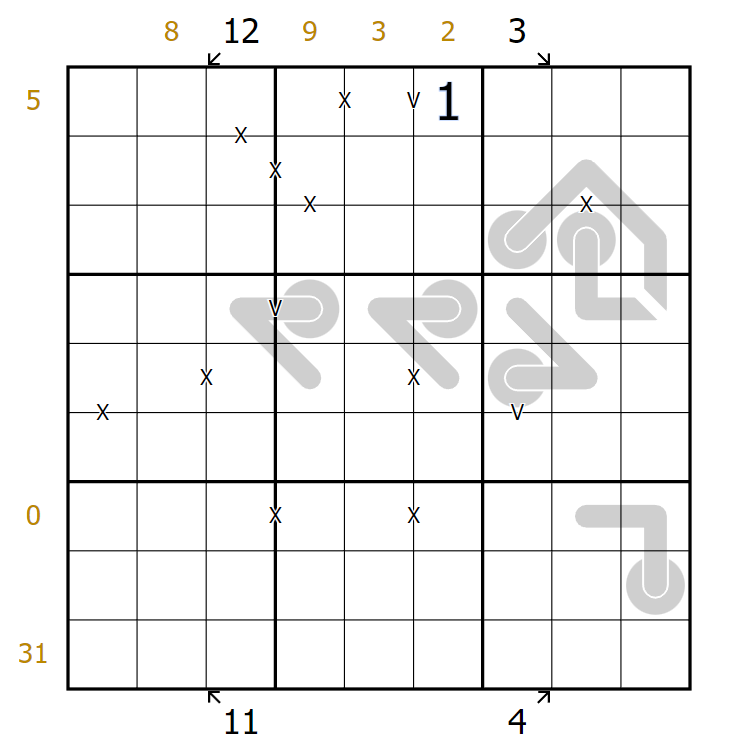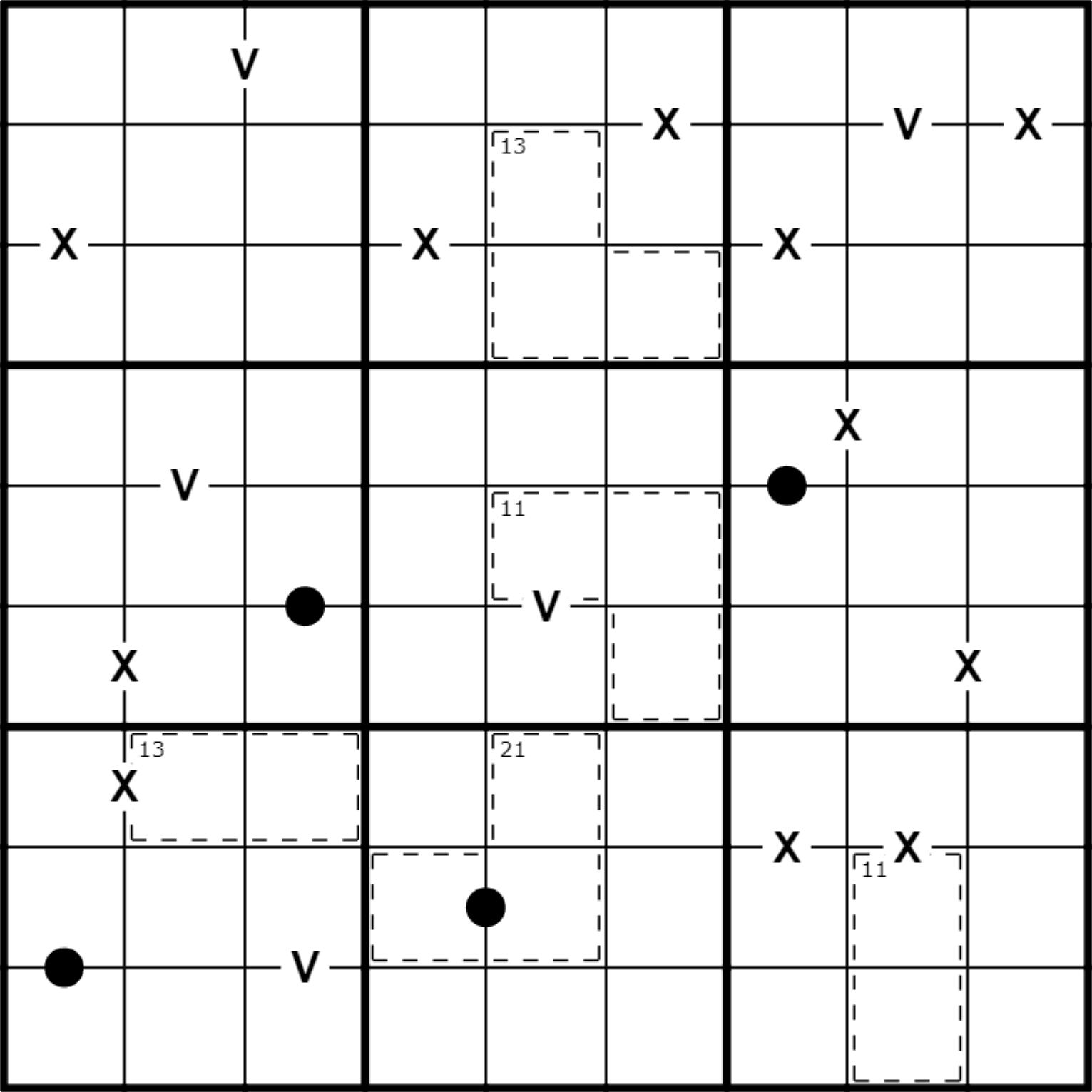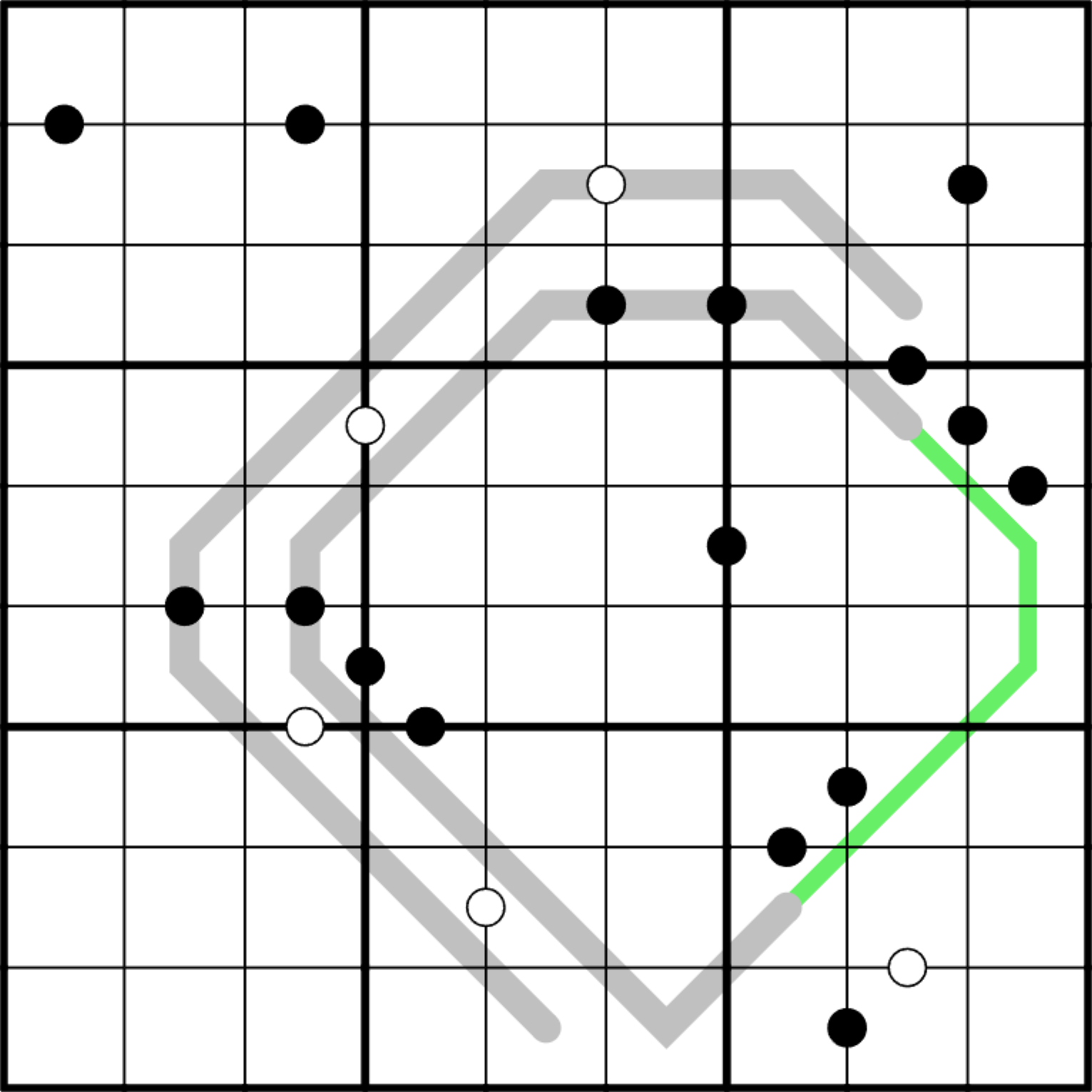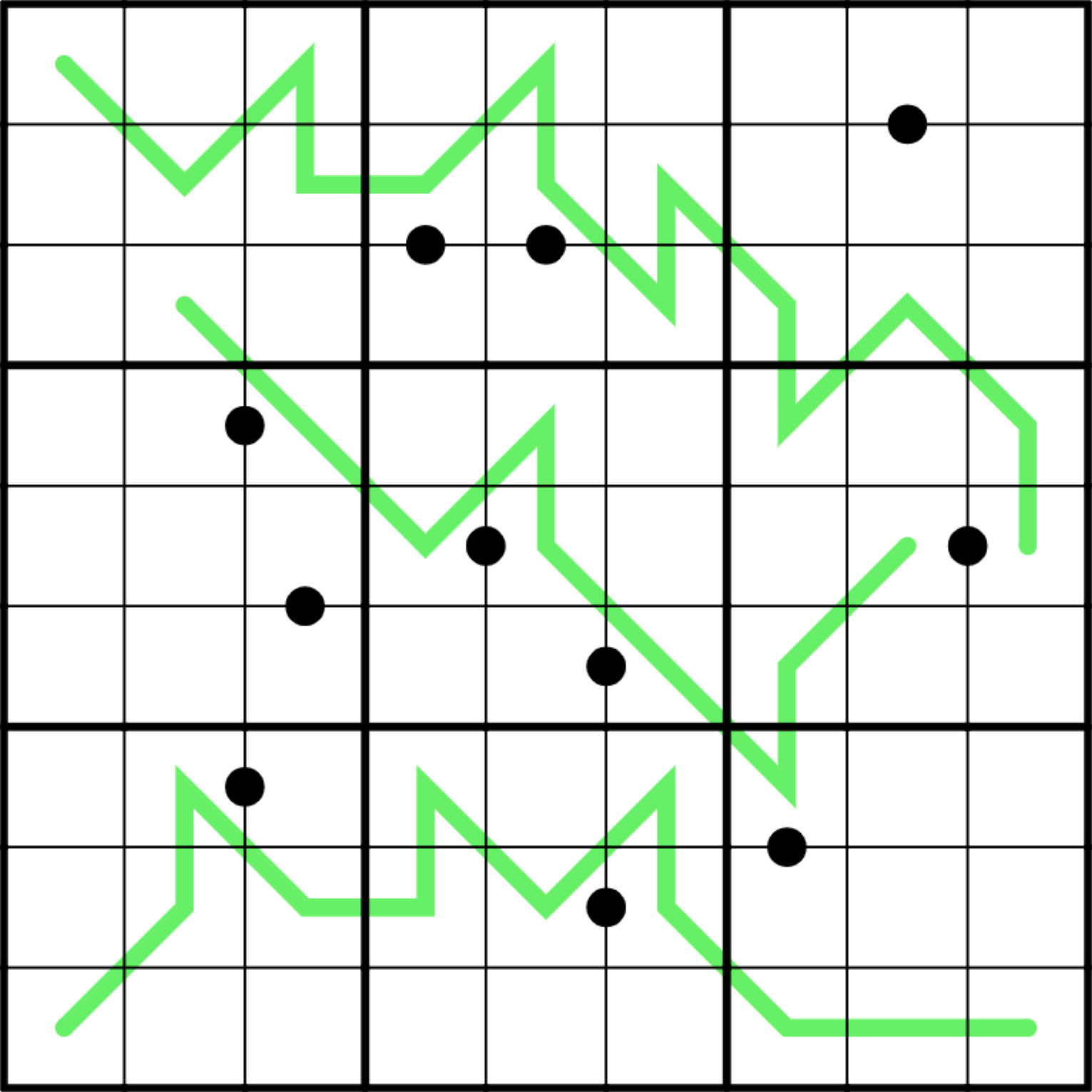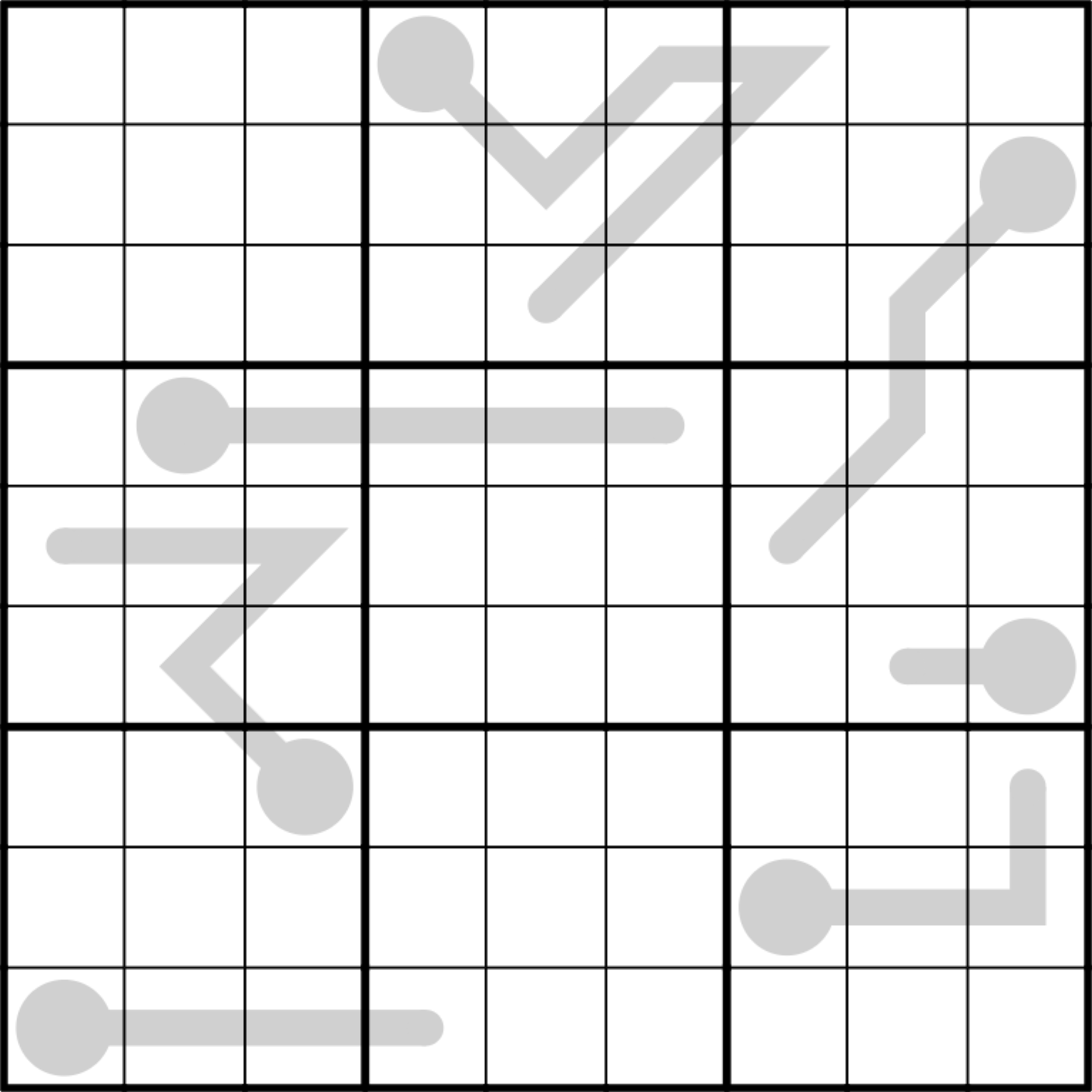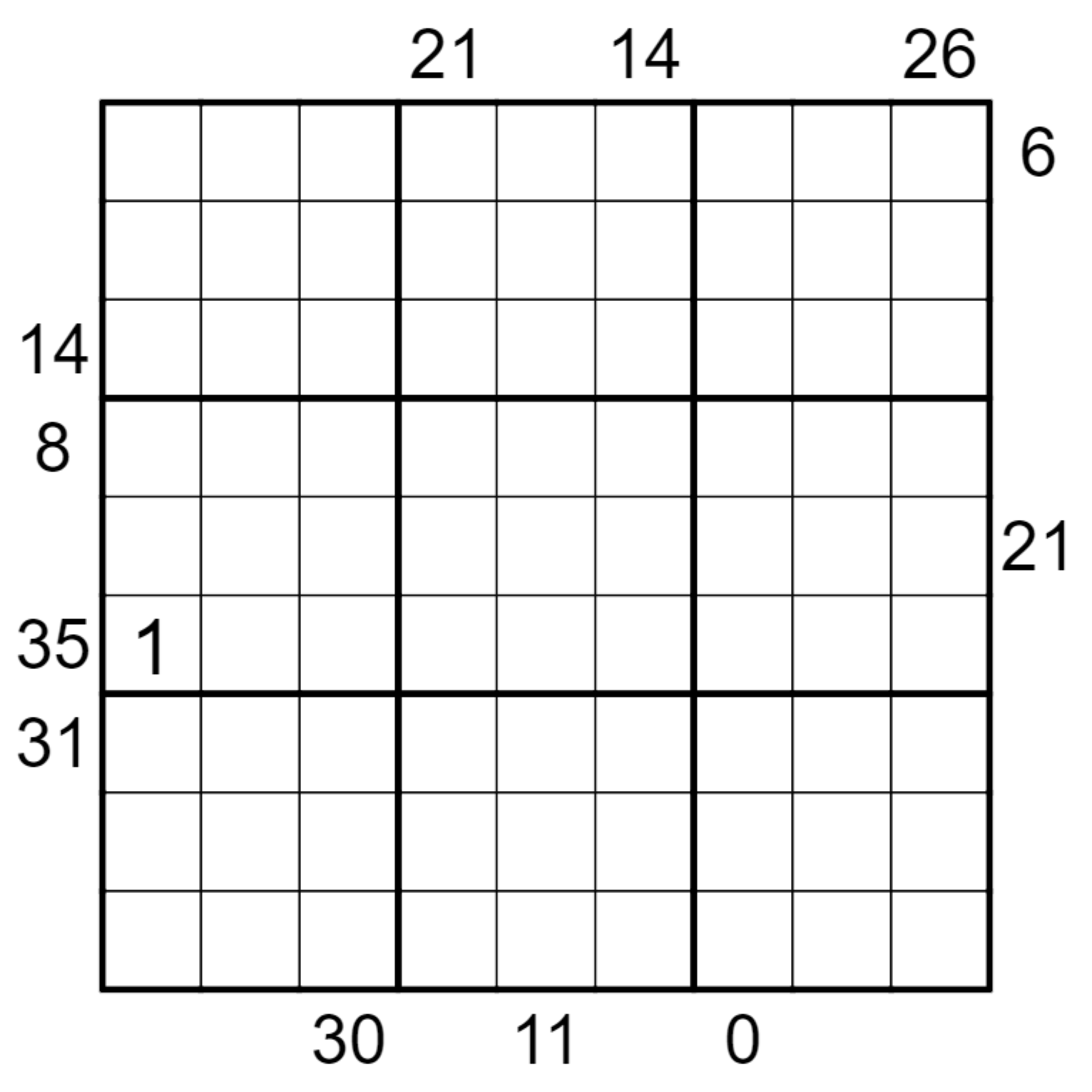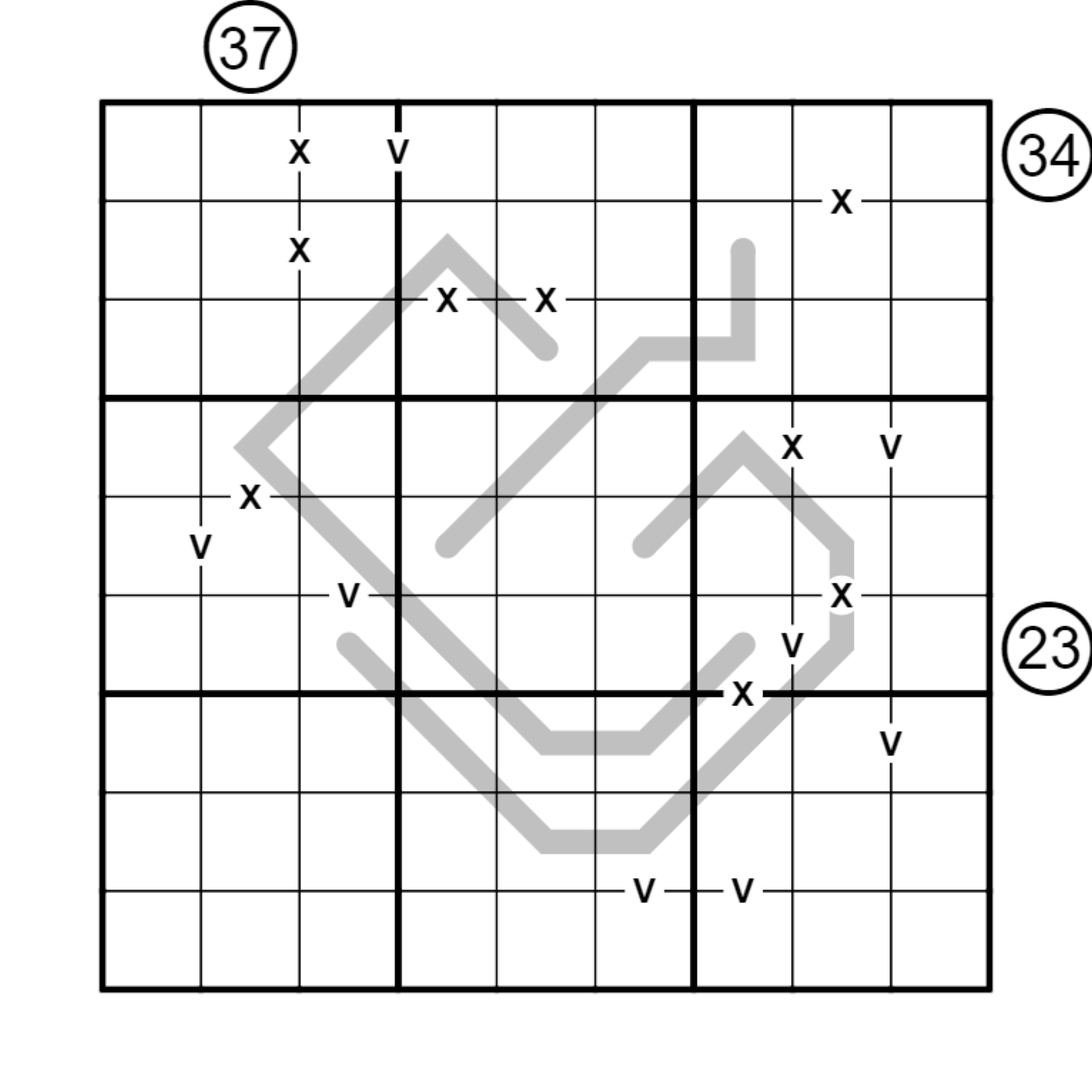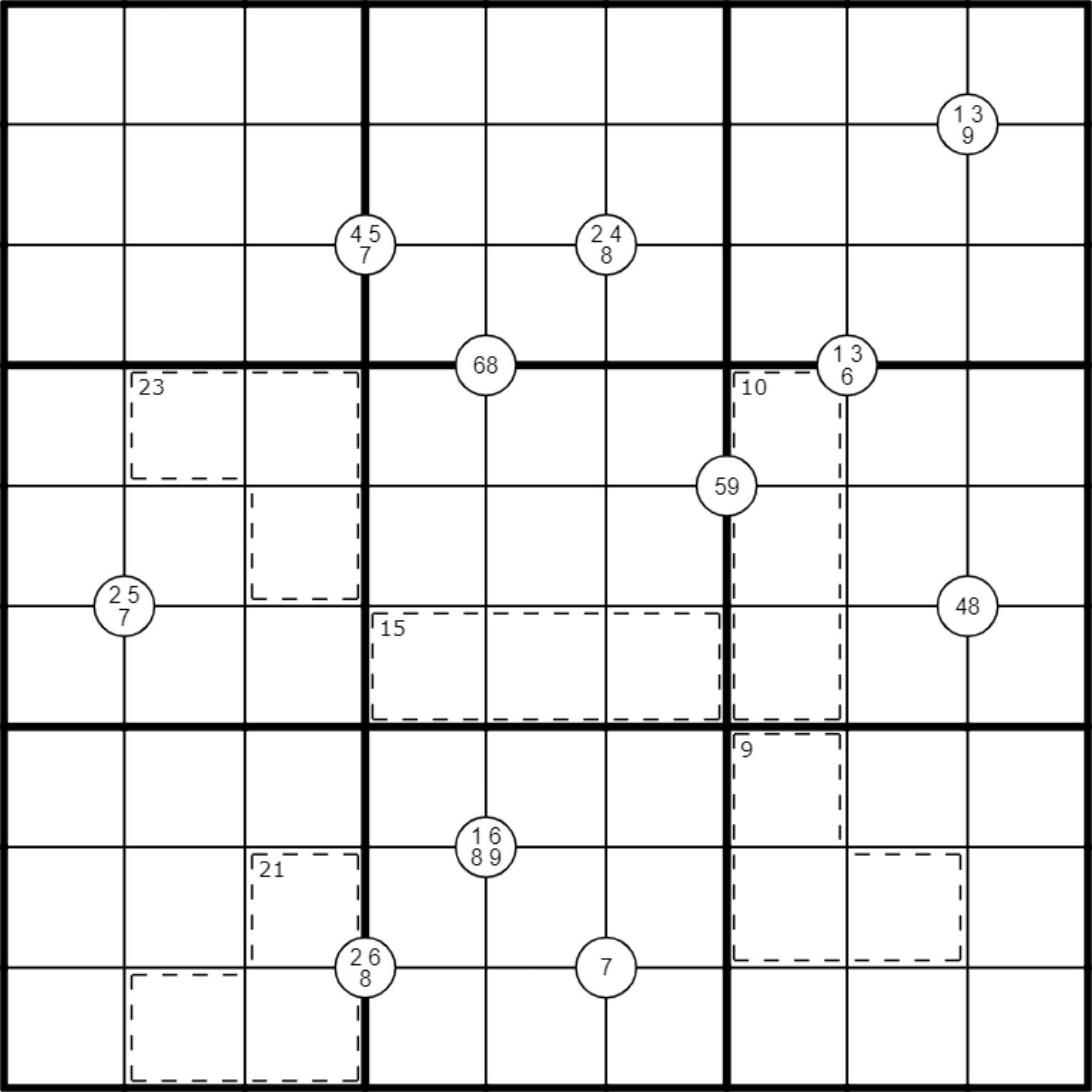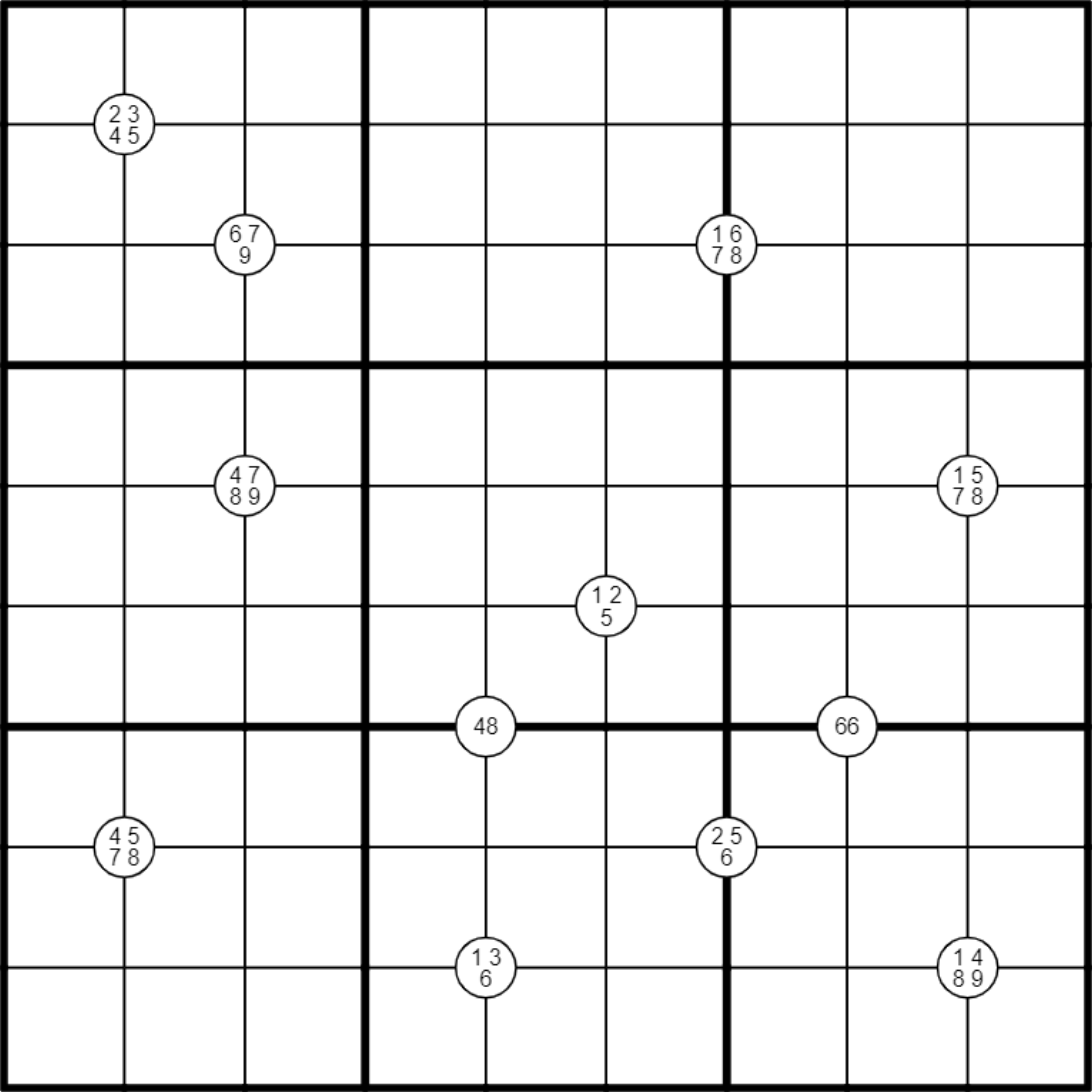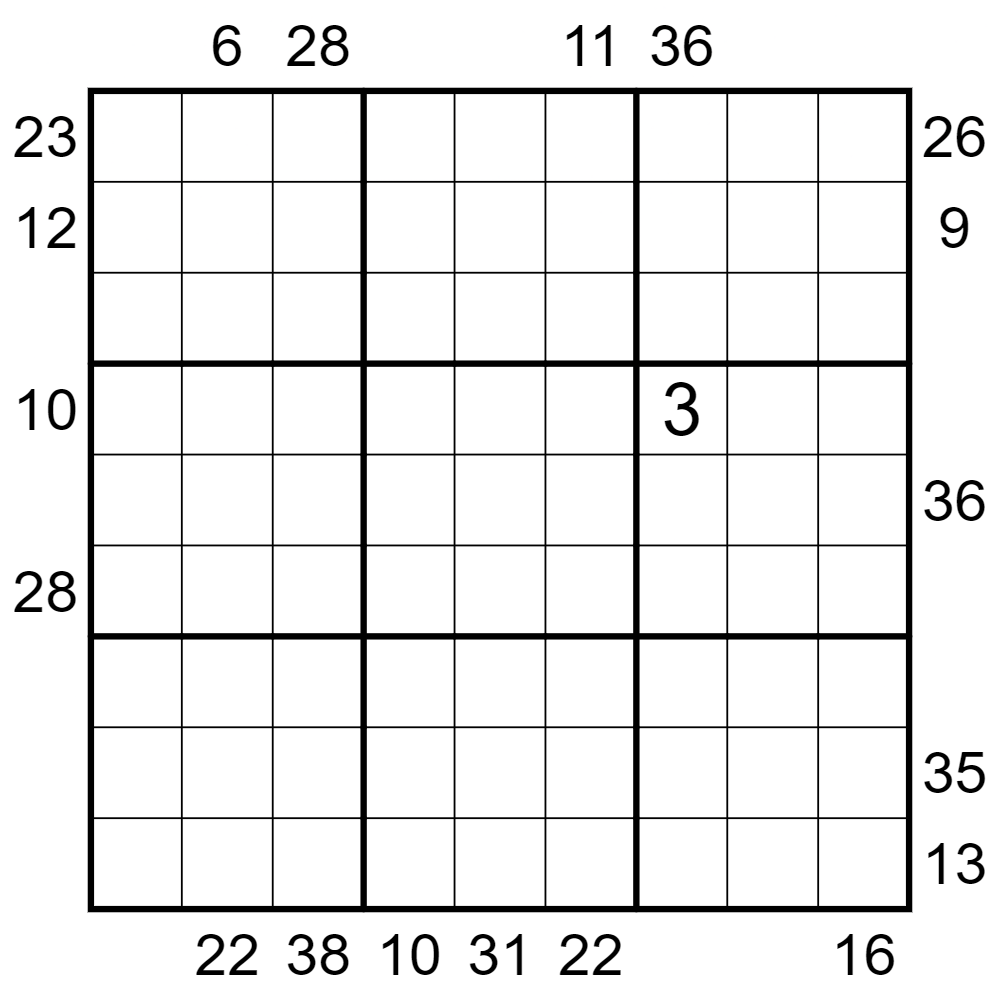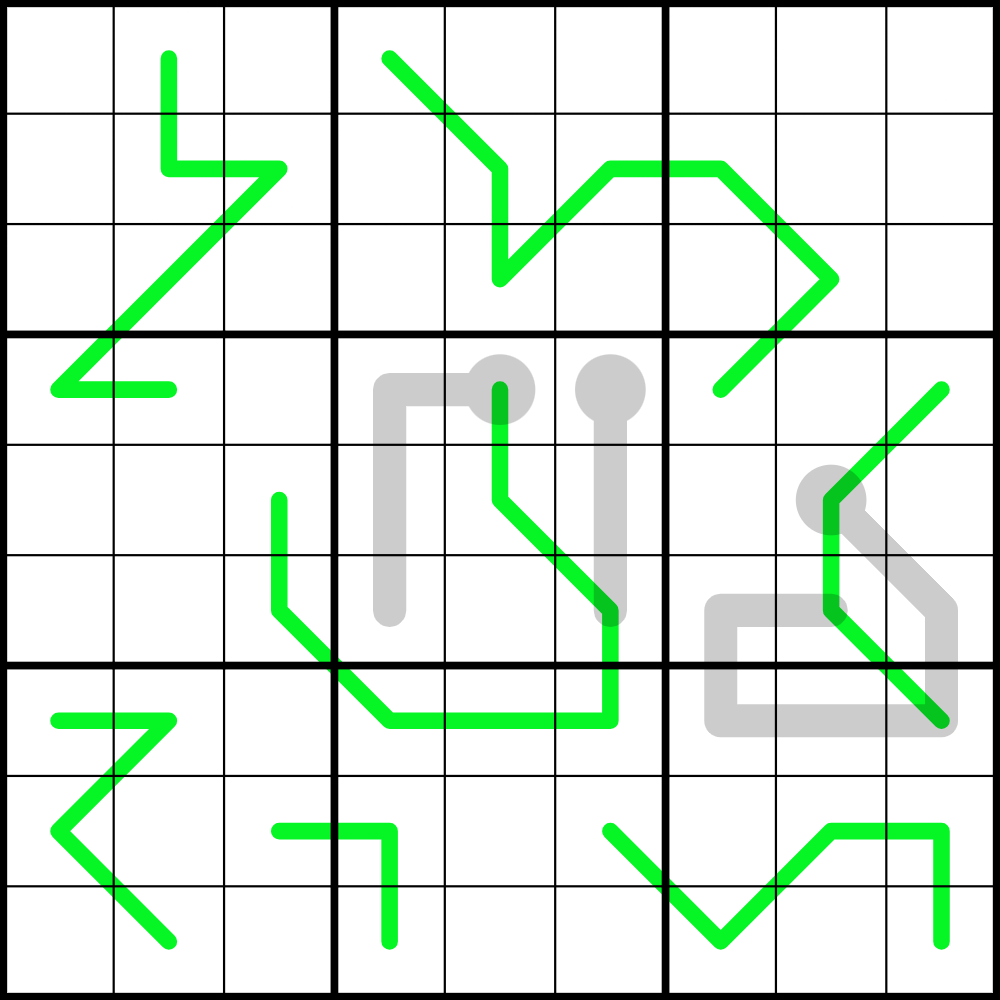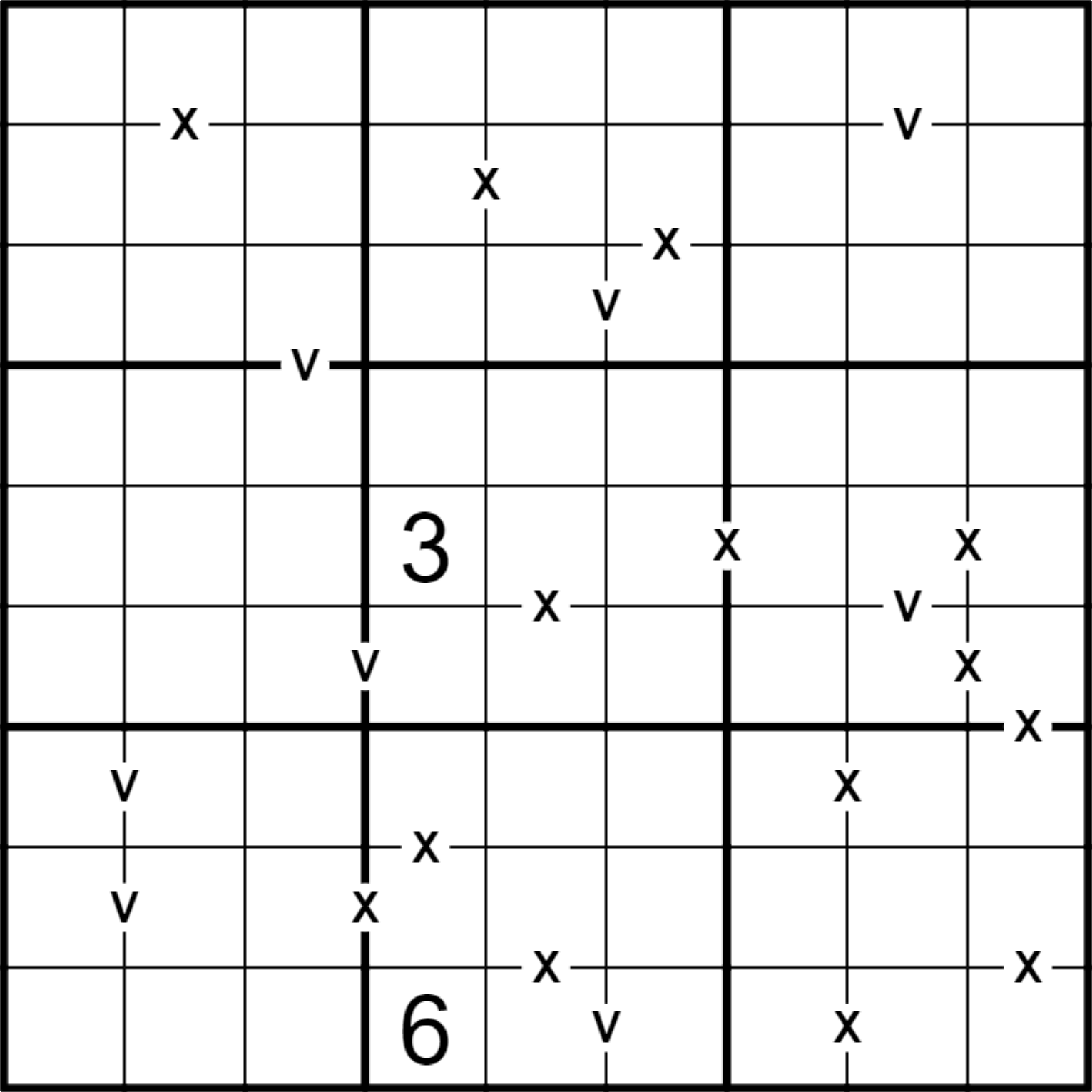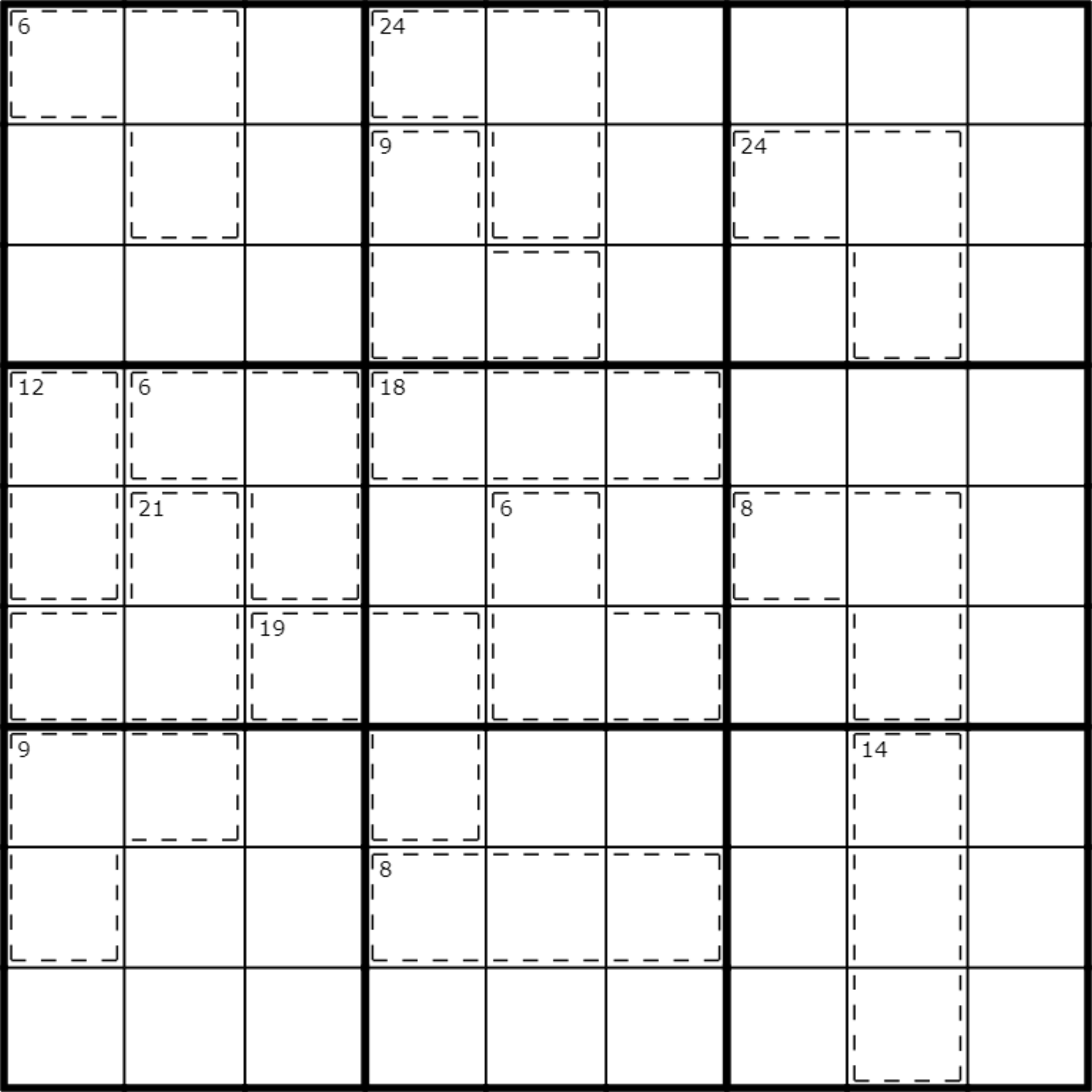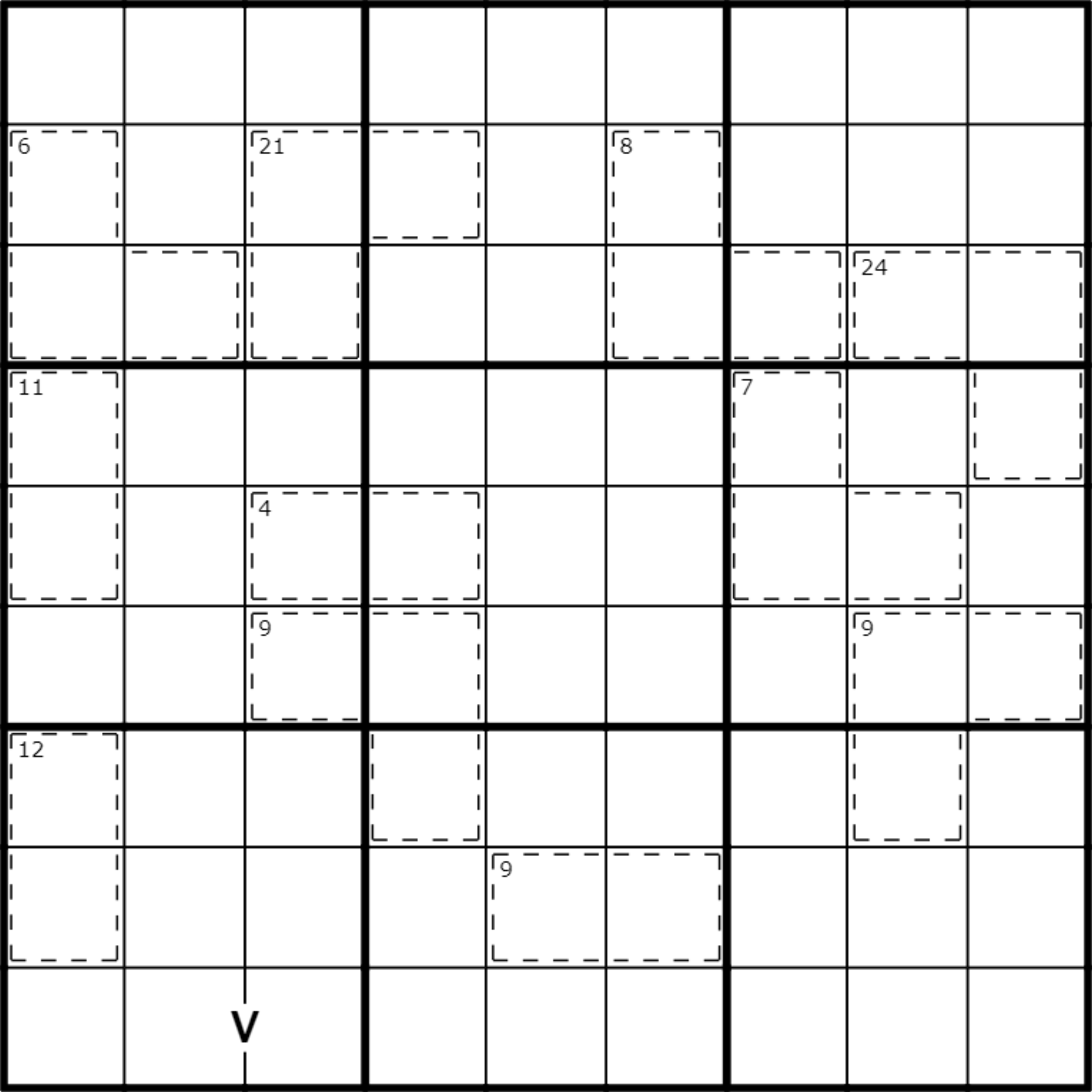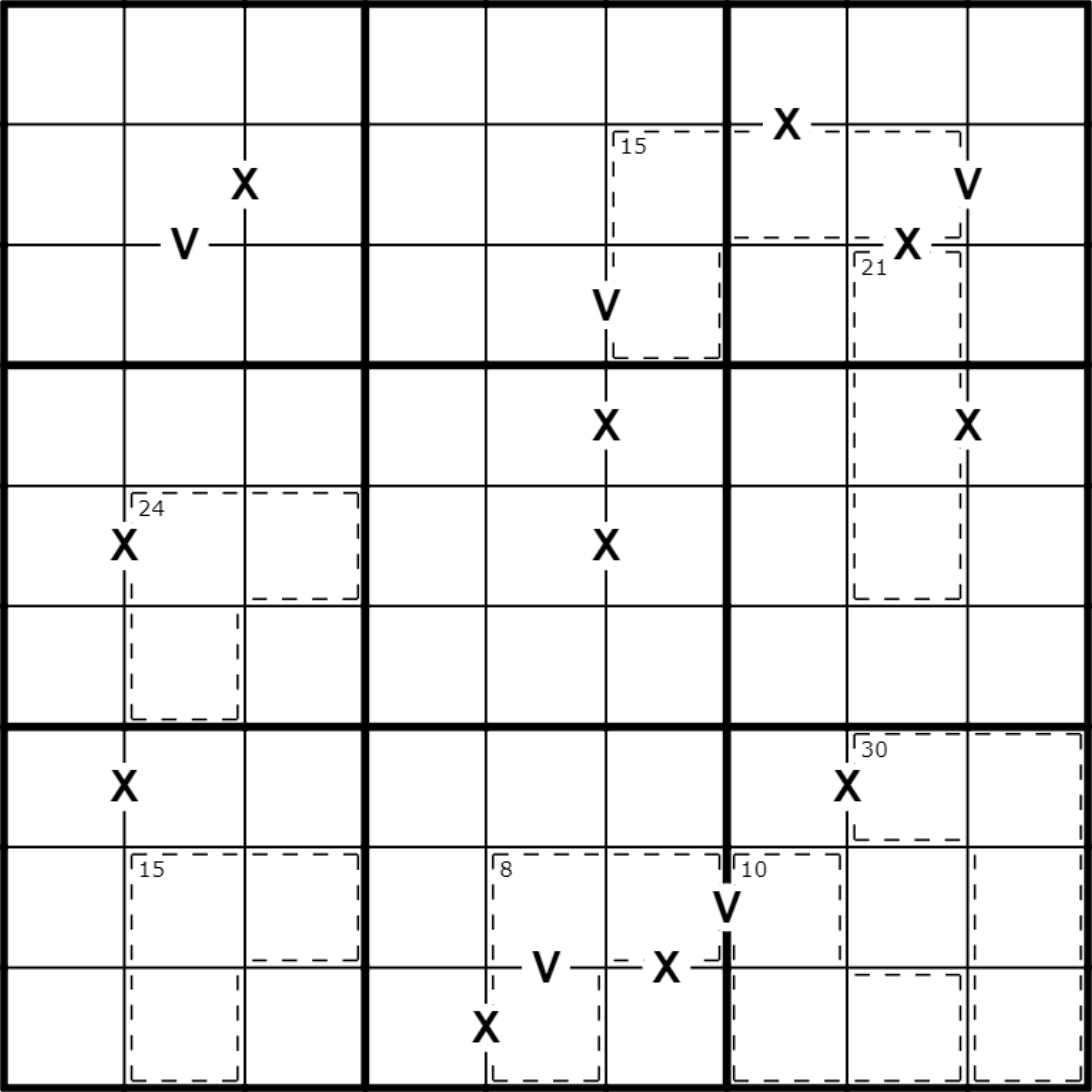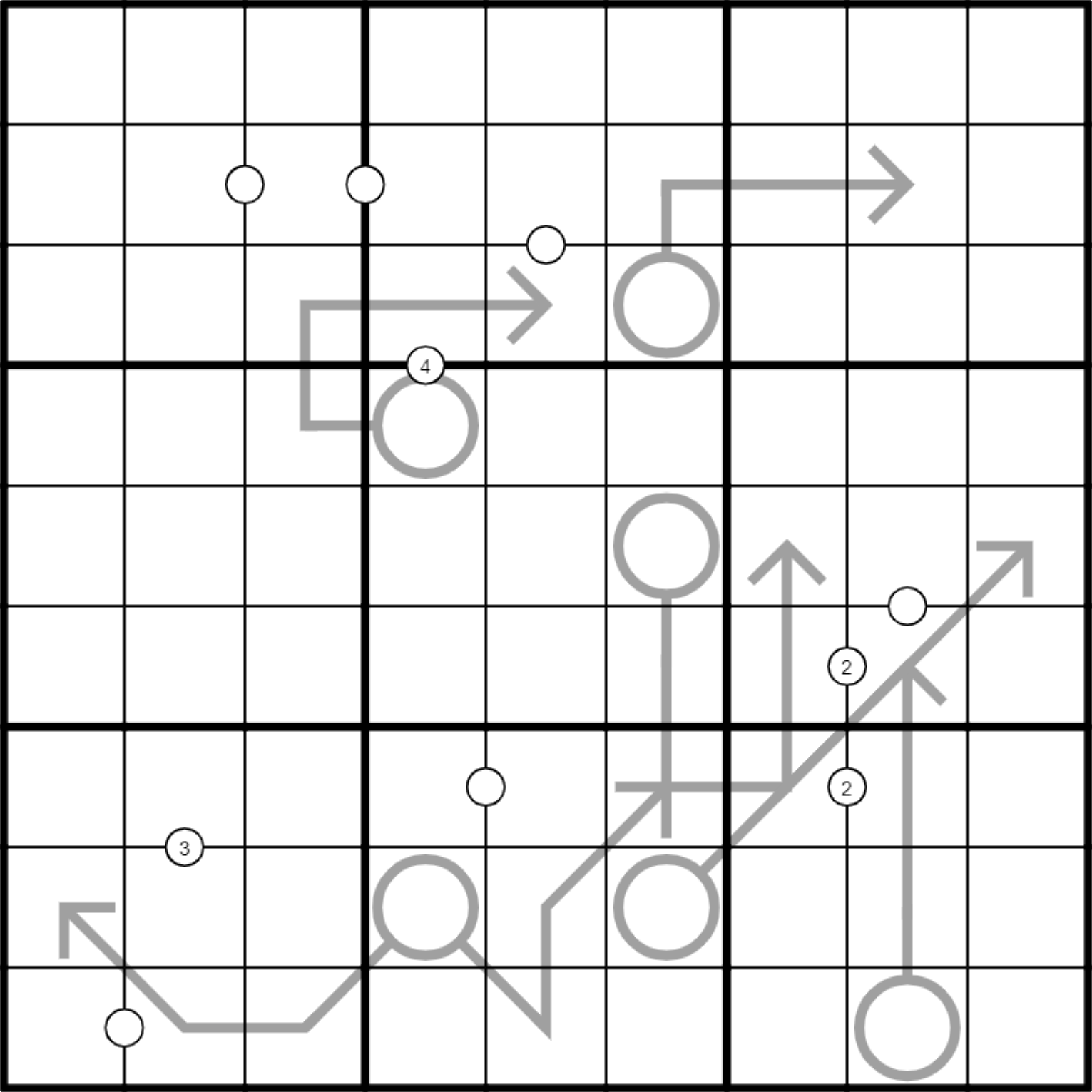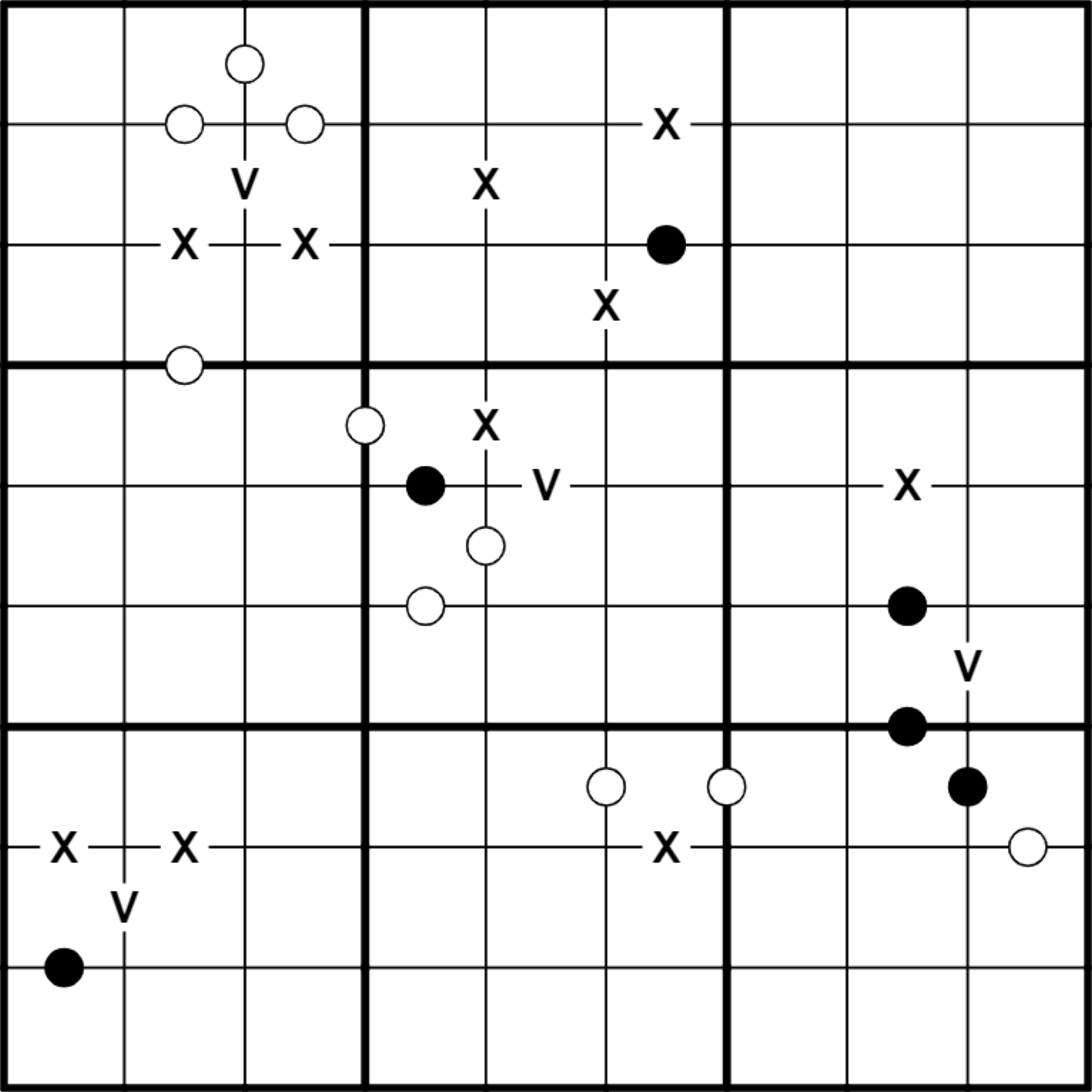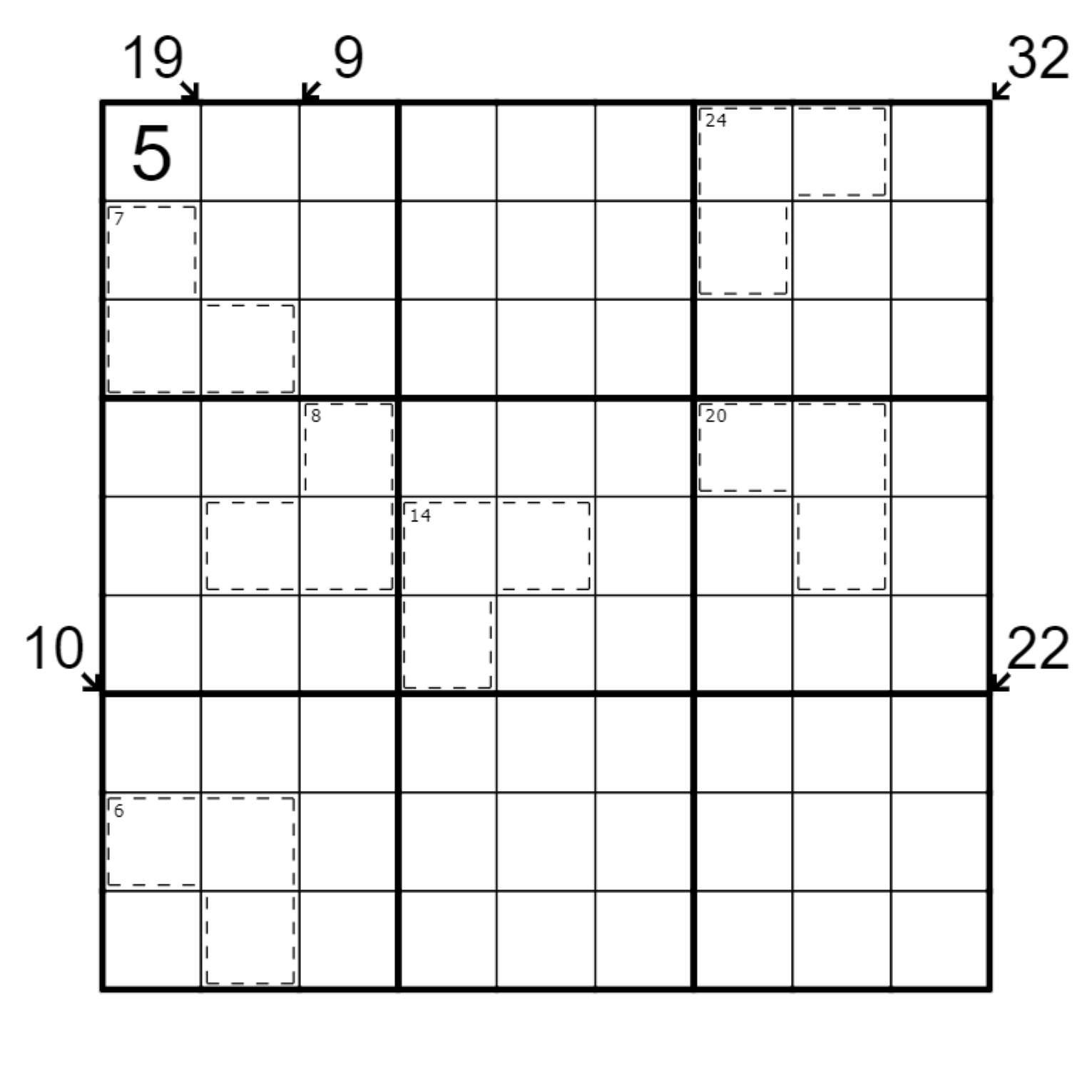Guide Arrow Puzzle Pack
by Kalliwyn
Download at:
Shade some empty cells so that no two shaded cells are orthogonally adjacent and the remaining unshaded cells form one orthogonally connected area. No complete loop of cells may be unshaded (including 2x2s). An arrow indicates the only direction in which one could begin a path to the star without going through a shaded cell or backtracking.
Around the World
by myShoggoth
Play at:
Normal sudoku rules apply. Digits separated by a white dot are consecutive. Not all dots are necessarily given. Digits separated by a V must sum to 5, and digits separated by an X must sum to 10. V and X are the roman numerals for 5 and 10, respectively.
X-Sums Snack
by myShoggoth
Play at:
Normal 6x6 sudoku rules apply. Clues outside the grid indicate the sum of the first X digits in that row or column, where X is the first digit seen.
Defined But Irregular Quads
by myShoggoth
Play at:
Normal sudoku rules apply. Digits inside the circles must appear in the surrounding cells. Digit in columns 1, 5, and 9 indicate the column where the 1 5, and 9 respectively can be found in its row - a 3 in column 1 means the 1 for that row is in its column 3. Regions are irregular.
Cage Batch
by myShoggoth
Play at:
Normal sudoku rules apply. Digits in killer cages sum to the number in the upper left of the cage and may not repeat.
Four Times Six Equals Eighteen
by myShoggoth
Play at:
Normal sudoku rules apply. Digits in cages sum to the number in the upper left and cannot repeat.
Slow Roll
by myShoggoth
Play at:
Normal sudoku rules apply. Digits along slow thermometers stay the same or increase as they move away from the bulb.
Yeeted Digits
by myShoggoth
Play at:
Normal sudoku rules apply. Digits in cages sum to the number in the upper left and cannot repeat.
I Gotcher Kropki
by myShoggoth
Play at:
Normal sudoku rules apply. Digits separated by a black dot have a 1:2 ratio, those separated by white dots are sequential. Not all black and white dots are necessarily given.
Equivalent Whispers
by myShoggoth
Play at:
Normal sudoku rules apply. Equal sum lines (blue) - sums within each box the line passes through are the same. German Whispers lines (green) - adjacent digits along the lines must differ by at least 5. Little killers - the number outside the grid is the sum of the digits of the indicated diagonal.
Big Step
by myShoggoth
Play at:
Normal 6x6 sudoku rules apply. Digits separated by black dots have a 1:2 ration, those separated by a white dot are consecutive. Not all black or white dots are necessarily given.
The Chains That Bind Us
by myShoggoth
Normal sudoku rules apply. Pairdoku - Two players work together to solve the puzzle, each grid has different information. Players may talk about what digits are possible or not possible in cells, but not describe the constraints or their rules. Each grid has the detailed ruleset.
The Mask
by myShoggoth
Play at:
Normal sudoku rules apply. Digits along slow thermometers stay the same or increase as they move away from the bulb.
Pairdoku Playground
by myShoggoth
Normal sudoku rules apply. Pairdoku - there are two different grids with the same solution, but not enough information to solve alone. Two solvers work together by sharing information on what digits are constrained, but not what the constraints are nor describing their grid. The grids are blurred above so too much information is not given out ahead of the solve. Each grid has information about its own constraints. These grids are generally domino constraints and killer cages.
Hatedoku
by myShoggoth
Play at:
Normal sudoku rules apply. Digits a chess knight's move apart cannot be the same. Disjoint Groups - Cells in the same position within two 3x3 boxes cannot contain the same digit. Digits along the diagonal line may not repeat.
Race to the Bullseye
by myShoggoth
Play at:
Normal sudoku rules apply. Digits in circles are equal to the sum of the digits on their arrow. Digits separated by a black dot have a 1:2 ratio. Not all black dots are necessarily given.
Whispers in the Dark
by myShoggoth
Play at:
Normal sudoku rules apply. Digits in clues at cell intersections must appear in the surrounding 4 cells. Adjacent digits along green lines must differ by at least 5.
Polymeter
by myShoggoth
Play at:
Normal sudoku rules apply. Digits strictly increase along thermometers starting from the bulb end.
Such modern. Wow.
by myShoggoth
Play at:
Normal sudoku rules apply. Digits separated by a black dot have a 1:2 ratio, those separated by a white dot are consecutive. Not all black or white dots are necessarily given. Digits along a double arrow sum to the sum of the digits in both connected circles.
Spooky Action at a Distance
by myShoggoth
Play at:
Normal sudoku rules apply. Cells in the same position relative to their 3x3 region must not contain the same digit. Digits on a thermometer must strictly increase as they move away from the bulb. Adjacent digits along green lines must differ by at least 5. Clues outside the grid indicate the sum of the first X digits in that row or column, where X is the first digit seen.
Quadromefel
by myShoggoth
Normal sudoku rules apply. Digits in circles must appear in one of the surrounding four cells. Digits orthagonal to each other may not be consecutive.
Ambiguous Murder Pun
by myShoggoth
Normal sudoku rules apply. Digits in cages sum to the number in the upper left and cannot repeat.
Yatta!
by myShoggoth
Normal sudoku rules apply. Digits separated by a small white dot are consecutive, those separated by a small black dot are in a 1:2 ratio. Digits separated by an X sum to 10, and those separated by a V sum to 5. Not all possible dots, Xs, and Vs are necessarily given.
Zappy Dots
by Kalliwyn
Play at:
Play at:
Normal sudoku rules apply. Cells separated by Xs sum to 10, Vs sum to 5. Digits separated by a black dot have a 1:2 ratio. Digits along green German Whisper lines must differ by at least 5. Not all Xs, Vs, or black dots are necessarily given.
Tiny, Silent, Deadly
by myShoggoth
Normal sudoku rules apply. Digits along green German Whispers lines must differ by at least 5. Digit outside the grid is the sum of the cells in the diagonal.
Circular Logic
by myShoggoth
Normal sudoku rules apply. Digits separated by a small white dot are consecutive, those separated by a small black dot are in a 1:2 ratio. Digits separated by an X sum to 10, and those separated by a V sum to 5. Not all possible dots, Xs, and Vs are necessarily given.
Stone Cold Killer
by myShoggoth
Normal sudoku rules apply. Digits in cages sum to the number in the upper left and cannot repeat.
Infinite City Sprawl
by myShoggoth
Play at:
Play at:
Normal sudoku rules apply. Cells with arrows pointing out must be higher than orthogonally adjacent digits.
Sick Day
by myShoggoth
Normal sudoku rules apply. Digits along thermometers must strictly increase from the bulb end. Black dots separate digits with a 1:2 ratio, digits separated by white dots are consecutive. Not all dots are necessarily given.
RIP City
by myShoggoth
Normal sudoku rules apply. Clues outside the grid indicate how many numbers are "seen" along the row/column, where being seen occurs when the number is larger than the digits closer to the clue.
One Year at Well, Actually
by myShoggoth
Normal sudoku rules apply. Digits along the green German Whisper lines must different by at least 5. Digits along the purple renban line are consecutive in any order. Numbers in the circles must in its surrounding cells.
Killer Break-in
by myShoggoth
Normal sudoku rules apply. Digits in killer cages sum to the number in the upper left of the cage and may not repeat.
Hex Bug
by Kalliwyn
Normal sudoku rules apply. Numbers outside the grid are sandwich sums, which show the sum of the numbers between 1 and 9 in the given row or column. Arrows outside the grid are little killers, which show the sum of all the digits on the given diagonal. Thermos must strictly increase from the bulb to the tip. Digits separated by a X must sum to ten, and digits separated by a V must sum to five. There are no negative constraints.
A Puzzle for Ruth
by myShoggoth
Normal sudoku rules apply. Digits separated by a V have sum to 5, those separated by an X sum to 10. Digits separated by a black dot have a 1:2 ratio. Digits in killer cages sum to the number in their upper left, and may not repeat within the cage. Not all Vs, Xs, and dots are necessarily given.
Gem and Mount
by myShoggoth
Normal sudoku rules apply. Grey lines are palindromes, digits must read the same from each end. The green line is german whispers, consecutive digits along the line must differ by at least 5. Black dots separate digits with a 1:2 ratio, white dots separate consecutive digits. Not all black or white dots are necessarily shown.
Cat Fancy
by myShoggoth
Normal sudoku rules apply. German whisper lines (green) - adjacent digits differ by at least 5. Digits separated by black dots have a 1:2 ratio. Not all black dots are necessarily given.
Keep 9 Safe
by myShoggoth
Normal sudoku rules apply. Orthogonally adjacent cells must not contain consecutive numbers. Digits must strictly increase along thermometers starting at the bulb end.
One is the Loneliest Corner
by myShoggoth
Normal sudoku rules apply. Disjoint Groups - Cells in the same position within two 3x3 boxes cannot contain the same digit. Sandwich - Clues outside the grid indicate the sum of the digits between the 1 and the 9 in their corresponding row or column.
Freckles
by myShoggoth
Normal sudoku rules apply. Digits separated by a black dot have a 1:2 ratio. Digits along a thermometer strictly increase from the bulb end, not necessarily consecutively.
Ttphtpthpthtpth
by myShoggoth
Normal sudoku rules apply. Digits along a gray palindrome line must read the same from both directions. Clues outside the grid indicate the sum of the first X digits in that row or column, where X is the first digit seen. Cells separated by an X must add up to 10, those separated by a V must add up to 5. Not all Xs and Vs are necessarily given.
What is leg day for?
by myShoggoth
Standard sudoku rules apply. Digits inside the circles must appear in the surrounding cells. Digits in cages must sum to the number in its top-left corner, and may not repeat within the cage.
My First Quadruples
by myShoggoth
Play at:
Play at:
Normal sudoku rules apply. Digits inside the circles must appear in the surrounding cells.
Three In The Inner Corner
by myShoggoth
Play at:
Play at:
Normal sudoku rules apply. X-sums The closest X digits to the clue in the corresponding row or column sum to the value of the X-Sums clue, where X is the first digit seen by the clue.
Picasso's Noses
by myShoggoth
Play at:
Play at:
Normal sudoku rules apply. Consecutive digits along the green German whisper line must differ by at least five. Digits along thermometers must strictly increase, not necessarily in consecutive order. Knightmare global constraint - Digits adding to 5 or 15 may not be a knight's move apart. There is no global anti-knight constraint.
Ratioed
by myShoggoth
Play at:
Play at:
Normal sudoku rules apply. Digits separated by a small white dot are consecutive, those separated by a small black dot are in a 1:2 ratio. Not all possible dots are necessarily given.
It Isn't About the 3 and 6
by myShoggoth
Play at:
Play at:
Normal sudoku rules apply. Digits separated by an X sum to 10, and those separated by a V sum to 5. All possible Xs, and Vs are necessarily given.
No Ratio For You
by myShoggoth
Normal sudoku rules apply. Digits in cages must add up to the total indicated and cannot repeat within the cage. Digits separated by black circle have a 1:2 ratio. All possible dots are given.
Negative Five Naked Singles
by myShoggoth
Normal sudoku rules apply. Digits in cages must add up to the total indicated and cannot repeat within the cage. Digits separated by an X sum to 10, and those separated by a V sum to 5. All possible Xs and Vs are given.
Sevens By Fives
by myShoggoth
Normal sudoku rules apply. Digits in cages must add up to the total indicated and cannot repeat within the cage. Digits separated by an X sum to 10, and those separated by a V sum to 5. Not all possible Xs and Vs are necessarily given.
Shrug
by myShoggoth
Play at:
Play at:
Normal sudoku rules apply. White dots separate digits that are the specified number apart, 1 if the dot is empty. The numbers along an arrow sum to the value in the circle.
Wink
by myShoggoth
Normal sudoku rules apply. Digits separated by a small white dot are consecutive, those separated by a small black dot are in a 1:2 ratio. Digits separated by an X sum to 10, and those separated by a V sum to 5. Not all possible dots, Xs, and Vs are necessarily given.
A Murder of Killers
by myShoggoth
Normal sudoku rules apply. Digits in cages must add up to the total indicated and cannot repeat within the cage. Numbers outside the grid indicate the total of the diagonal pointed to by the arrow.
